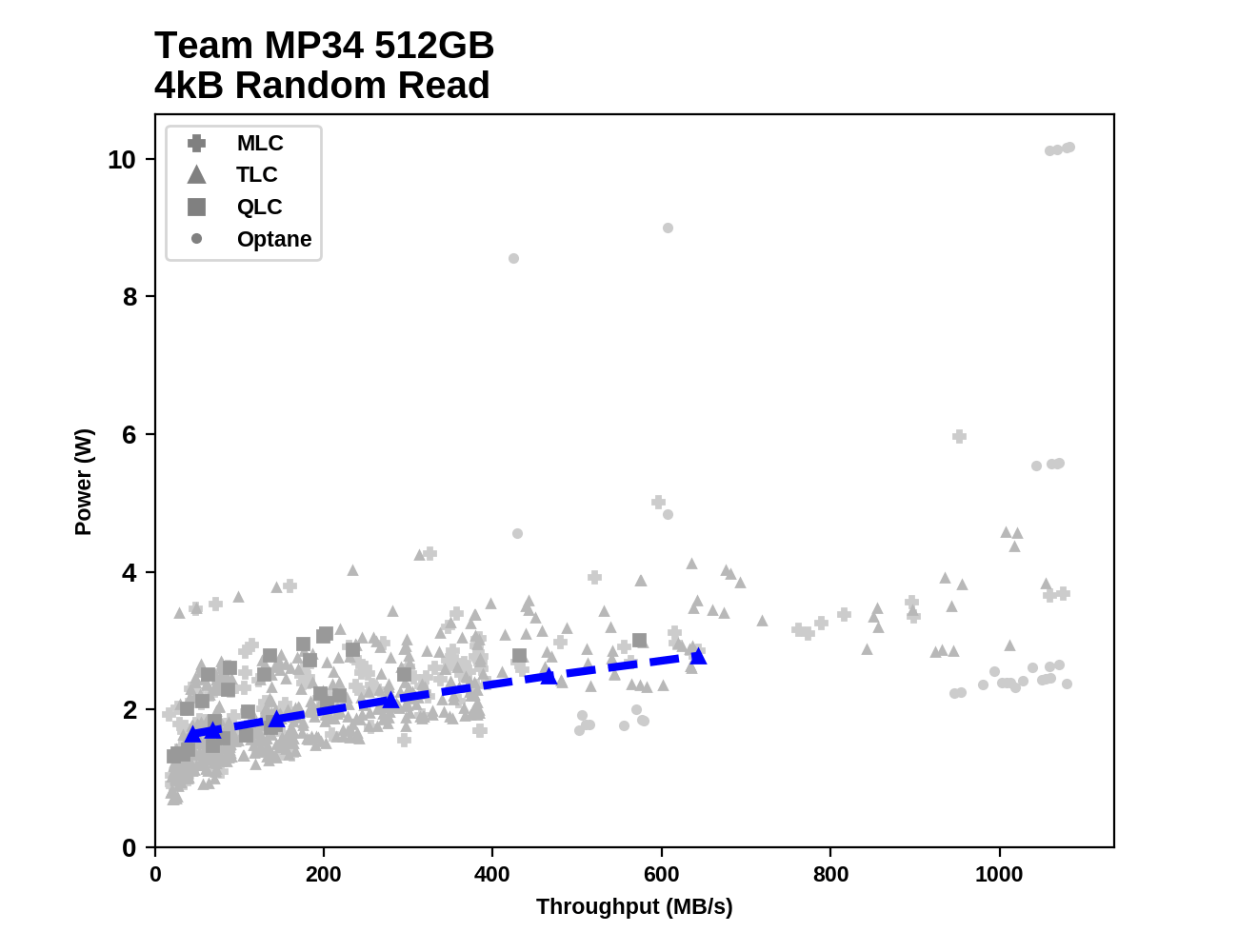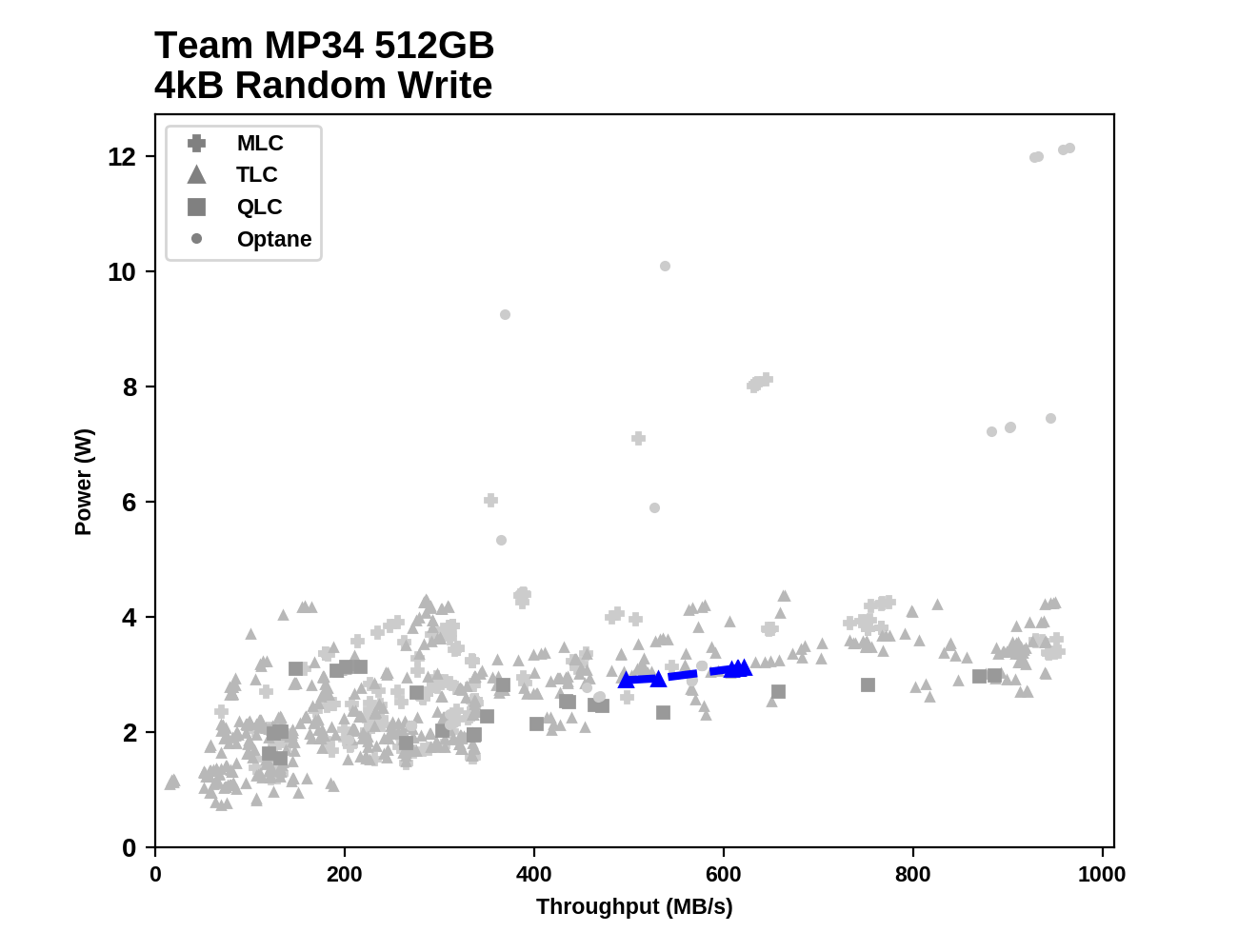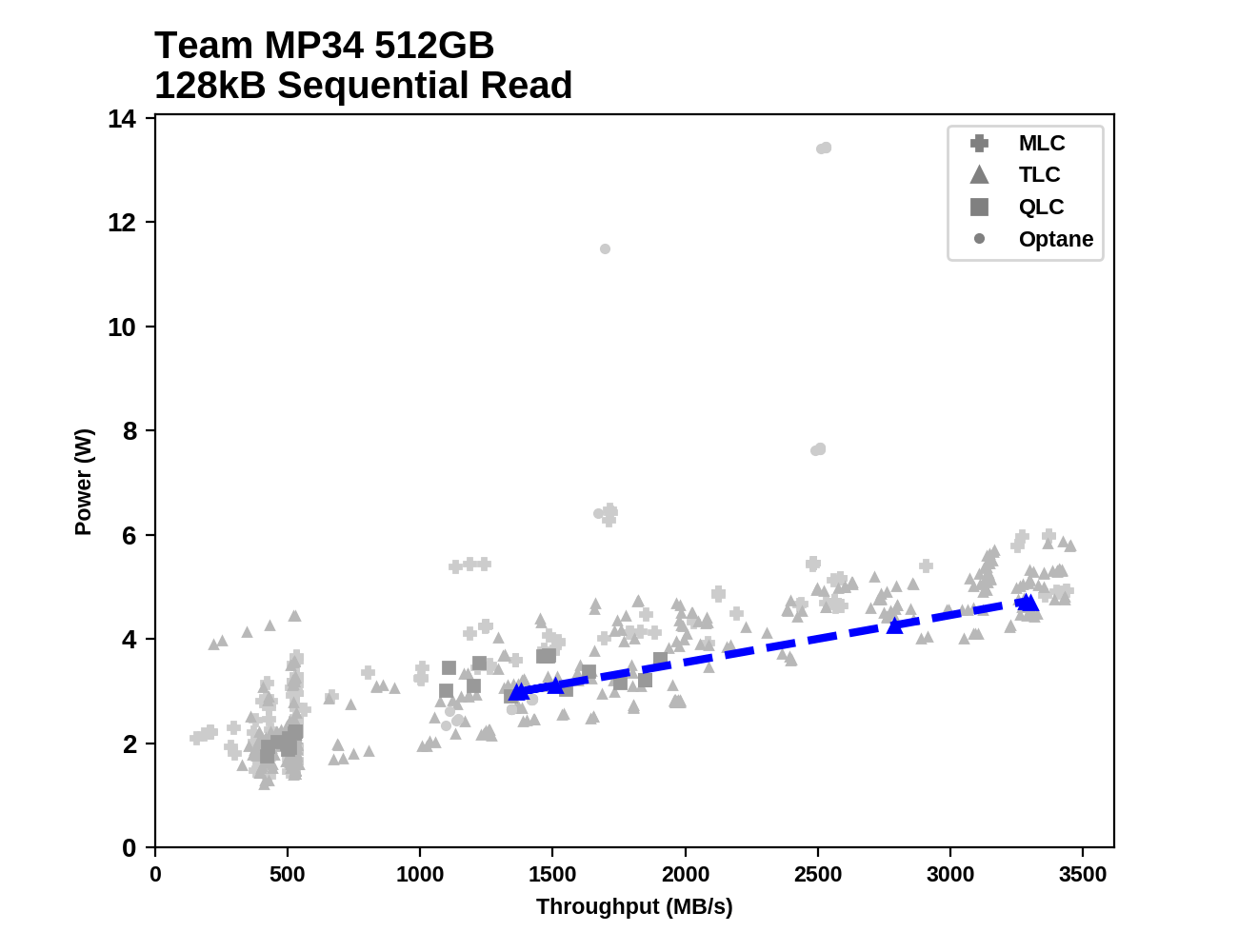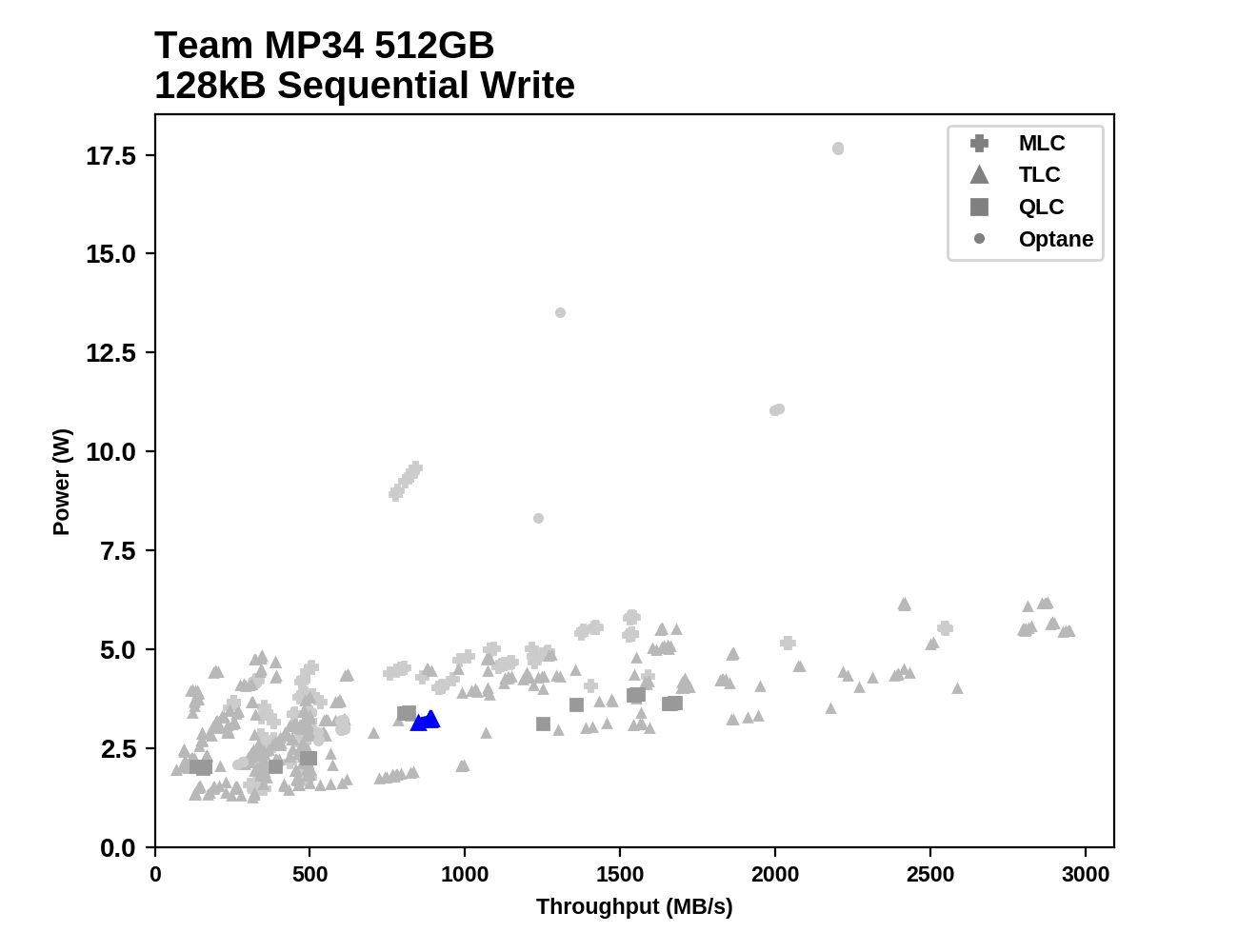
Original Link: https://www.anandtech.com/show/14331/the-team-group-mp34-512gb-ssd-review
The Team Group MP34 512GB SSD Review: Refining Phison's NVMe Workhorse
by Billy Tallis on May 15, 2019 9:00 AM EST- Posted in
- Storage
- SSDs
- Toshiba
- Phison
- M.2
- NVMe
- BiCS
- 3D TLC
- Team Group
- PS5012-E12
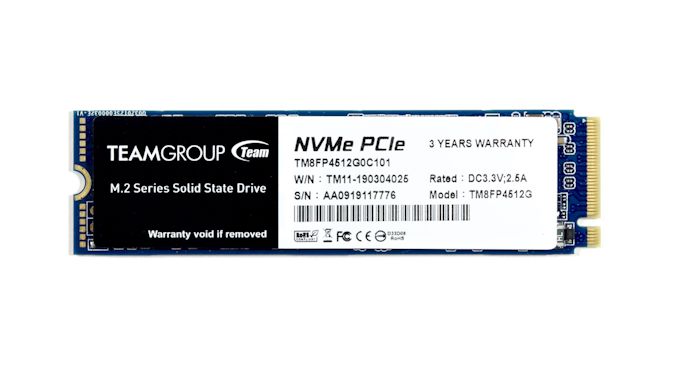
NVMe SSDs are well on their way to becoming the mainstream choice for primary storage in consumer PCs. There is a wide array of options from every brand on the market, and thanks to the past year's price drops for flash memory, these formerly high-end drives for enthusiasts have become quite enticing. This is especially the case at the lower capacities, where the price premiums over SATA SSDs are usually no more than $10-20.
Team Group's current top of the line SSD is the simply named MP34: an M.2 NVMe SSD with a PCIe 3.0 x4 interface. The MP34 uses the standard Phison E12 controller reference design with Toshiba 64L 3D TLC NAND flash memory, which is a pretty familiar combination now that we're about half way through that controller's product cycle.
Drives using this controller and NAND combination have never been the fastest on the market, but they've consistently been fast enough to satisfy enthusiasts looking to round out a high-end workstation or gaming machine. However, Phison-based SSDs usually don't command the kind of price premium that top brands like Samsung and Western Digital can charge, so the Team MP34 isn't exclusively for enthusiasts. The drive is just as suitable for everyday use in a notebook computer, where it promises a step up from SATA performance without breaking the bank or killing battery life. (Toshiba/SanDisk 64-layer 3D NAND seems to be the most power efficient option for this generation, and it's fast enough to stay competitive against 64L NAND from Intel, Micron and Samsung.)
As with many other Phison partners, this is Team Group's first opportunity to sell a true high-end NVMe SSD. Phison's first generation NVMe controller was a disappointment, and tactics like adding a fancy heatsink couldn't change the fact that it was too slow to be a serious competitor. Phison's second generation of NVMe controllers got off to a good start with the entry-level E8 (used in the Team MP32), but the high-end E12 didn't arrive until late last year.
There are many brands selling drives based on this platform, and the differences tend to be minor. Most of the Phison E12 drives we've tested or been offered for review have been 1TB models, leaving us with an incomplete picture of how that platform holds up at the lower capacities that are more affordable and more popular. We recently tested Gigabyte's Aorus RGB SSD at 256GB and 512GB, but its non-standard design with a substantial heatsink and RGB lighting mean its performance and power efficiency results aren't particularly representative of most other Phison E12 drives. The Team MP34 gives us the chance to assess the standard E12 design at a lower capacity where providing the best performance is more of a challenge.
The Team Group MP34 is also our first E12 drive to arrive with the latest 12.2 firmware from Phison. Phison's first generation NVMe controller—the PS5007-E7— hit the retail market with firmware that was functional but definitely immature. Over a span of more than a year, Phison delivered numerous updates that brought bug fixes and significant performance changes (not always for the better). The firmware for the Phison E12 was much more mature to begin with; our testing of a pre-release engineering sample showed that the platform was already prepared to compete in the high-end SSD market, so we expect more in the way of subtle refinements than big changes.
More recently however, Phison's rival Silicon Motion recently re-released their competing SM2262 controller as the SM2262EN with firmware providing a substantially different performance profile that focuses specifically on improving peak performance. So we need to keep an eye on Phison's progress to see how they respond in the short term while preparing their next generation controller ASIC, the Phison E16 that is due to bring PCIe 4.0 support to the retail market by the end of the year.
| Team Group MP34 SSD Specifications | |||||
| Capacity | 256 GB | 512 GB | 1 TB | ||
| Form Factor | M.2 2280 PCIe 3 x4 | ||||
| Controller | Phison PS5012-E12 | ||||
| NAND Flash | Toshiba 64L 3D TLC | ||||
| Sequential Read | 2700 MB/s | 3000 MB/s | 3000 MB/s | ||
| Sequential Write | 850 MB/s | 1700 MB/s | 2600 MB/s | ||
| Random Read | 190k IOPS | 190k IOPS | 180k IOPS | ||
| Random Write | 160k IOPS | 160k IOPS | 160k IOPS | ||
| Warranty | 3 years | ||||
| Write Endurance | 380 TB | 800 TB | 1660 TB | ||
| Current Retail Price | $41.99 (16¢/GB) |
$74.99 (15¢/GB) |
$159.99 (16¢/GB) |
||
Team Group's spec sheet for the MP34 lists the drive as offering fairly typical performance for high-end NVMe SSDs this generation. The random IO performance ratings are similar across all capacities (with random reads actually rated to be slightly faster for the smaller models), but sequential write speeds are highly dependent on drive capacity. Team Group hasn't announced a 2TB version and the warranty period is only three years, so the MP34 is aiming slightly below the top of the market. The write endurance ratings are still competitive with high-end drives that offer five year warranties, so it doesn't appear that Team is really cutting any corners. The shorter warranty period should be little concern if the MP34 is priced appropriately.
Team Group has opted for a relatively low overprovisioning ratio and consequently higher usable capacities. We're testing a 512GB drive, but there are also 480GB and 500GB Phison E12 drives on the market. At the 1TB capacity these differences in usable capacity don't seem to be strongly influencing performance of E12 drives, but the situation may be different at lower capacities where write performance is more limited. However, so far it looks like the higher usable capacities perform fine and any sacrifices are worth the improvement in price per GB.
The Competition
It's hard to keep track of all the Phison E12 SSDs on the market, let alone which firmware version is shipping from each brand (few Phison partners are reliable about delivering aftermarket firmware updates). The ones we've tested are the Corsair MP510 with an early 11.0 firmware, and the Silicon Power P34A80 and Gigabyte Aorus RGB with the 12.1 firmware. These older Phison E12 drives are highlighted in the graphs in this review. Beyond the Phison E12 drives, the most important competitors are Silicon Motion SM2262EN drives like the ADATA XPG SX8200 Pro and HP EX950, and flagship TLC drives from the vertically-integrated major manufacturers: the Samsung 970 EVO Plus and WD Black SN750. We don't have 512GB-class samples for many of those drives, so this review includes a mix of results from current-generation 1TB class drives and year-old 480-512GB drives.
| AnandTech 2018 Consumer SSD Testbed | |
| CPU | Intel Xeon E3 1240 v5 |
| Motherboard | ASRock Fatal1ty E3V5 Performance Gaming/OC |
| Chipset | Intel C232 |
| Memory | 4x 8GB G.SKILL Ripjaws DDR4-2400 CL15 |
| Graphics | AMD Radeon HD 5450, 1920x1200@60Hz |
| Software | Windows 10 x64, version 1709 |
| Linux kernel version 4.14, fio version 3.6 | |
| Spectre/Meltdown microcode and OS patches current as of May 2018 | |
- Thanks to Intel for the Xeon E3 1240 v5 CPU
- Thanks to ASRock for the E3V5 Performance Gaming/OC
- Thanks to G.SKILL for the Ripjaws DDR4-2400 RAM
- Thanks to Corsair for the RM750 power supply, Carbide 200R case, and Hydro H60 CPU cooler
- Thanks to Quarch for the HD Programmable Power Module and accessories
- Thanks to StarTech for providing a RK2236BKF 22U rack cabinet.
Whole-Drive Fill
This test starts with a freshly-erased drive and fills it with 128kB sequential writes at queue depth 32, recording the write speed for each 1GB segment. This test is not representative of any ordinary client/consumer usage pattern, but it does allow us to observe transitions in the drive's behavior as it fills up. This can allow us to estimate the size of any SLC write cache, and get a sense for how much performance remains on the rare occasions where real-world usage keeps writing data after filling the cache.
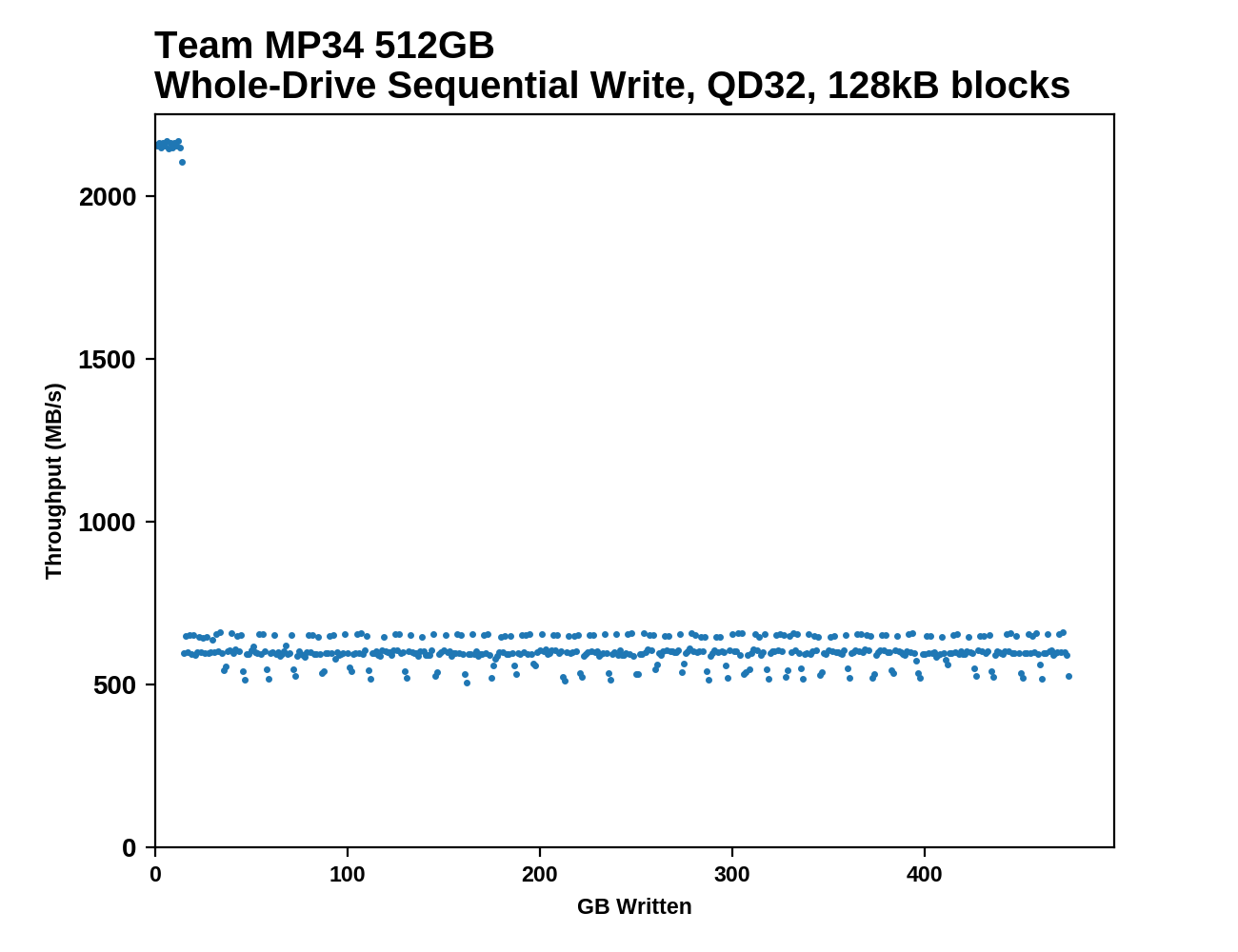 |
|||||||||
The Team Group MP34's use of the latest 12.2 firmware for the Phison E12 controller brings another visible change in the long-term write behavior. After the SLC write cache is filled, we no longer see periodic jumps back up to full SLC write speed; instead, the MP34's post-SLC write speed is very consistent, and a bit higher than on previous firmware. The SLC cache seems to be about 14-15GB on this 512GB drive, which is 1-2GB larger than on the 512GB Gigabyte Aorus RGB.
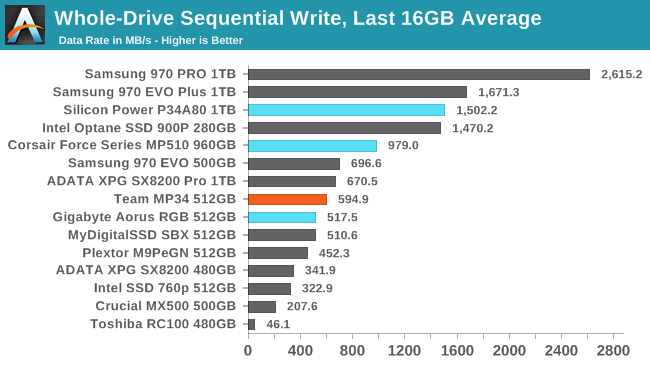 |
|||||||||
| Average Throughput for last 16 GB | Overall Average Throughput | ||||||||
The more consistent sustained write performance of the newer firmware also brings a slight overall performance increase, with about a 3% increase in speed for filling the entire drive. The 512GB E12 drives aren't too far behind Samsung on this metric, but the 1TB drives (all with older firmware) are far slower than Samsung's latest.
BAPCo SYSmark 2018
BAPCo's SYSmark 2018 is an application-based benchmark that uses real-world applications to replay usage patterns of business users, with subscores for productivity, creativity and responsiveness. Scores represnt overall system performance and are calibrated against a reference system that is defined to score 1000 in each of the scenarios. A score of, say, 2000, would imply that the system under test is twice as fast as the reference system.
SYSmark scores are based on total application response time as seen by the user, including not only storage latency but time spent by the processor. This means there's a limit to how much a storage improvement could possibly increase scores, because the SSD is only in use for a small fraction of the total test duration. This is a significant difference from our ATSB tests where only the storage portion of the workload is replicated and disk idle times are cut short to a maximum of 25ms.
| AnandTech SYSmark SSD Testbed | |
| CPU | Intel Core i5-7400 |
| Motherboard | ASUS PRIME Z270-A |
| Chipset | Intel Z270 |
| Memory | 2x 4GB DDR4-2666 CL15 |
| Case | In Win C583 |
| Power Supply | Cooler Master G550M |
| OS | Windows 10 64-bit, version 1803 |
Our SSD testing with SYSmark uses a different test system than the rest of our SSD tests. This machine is set up to measure total system power consumption rather than just the drive's power.
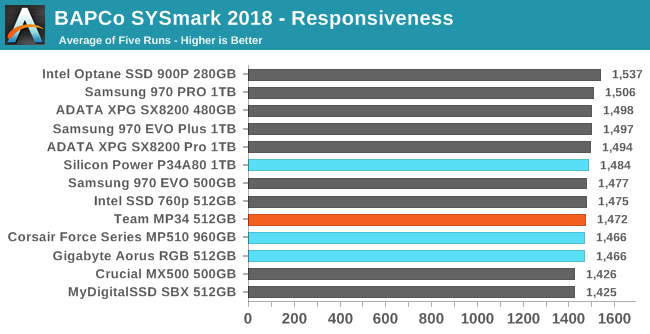 |
|||||||||
| Creativity | Productivity | Responsiveness | Overall | ||||||
SYSmark 2018 is not a very storage-intensive test, so only the Responsiveness subscore shows a clear difference between SATA and NVMe SSDs. The Team MP34's performance is a few points higher than the Gigabyte Aorus RGB SSD, but this is within the ordinary variation between runs.
Energy Usage
The SYSmark energy usage scores measure total system power consumption, excluding the display. Our SYSmark test system idles at around 26 W and peaks at over 60 W measured at the wall during the benchmark run. SATA SSDs seldom exceed 5 W and idle at a fraction of a watt, and the SSDs spend most of the test idle. This means the energy usage scores will inevitably be very close. A typical notebook system will tend to be better optimized for power efficiency than this desktop system, so the SSD would account for a much larger portion of the total and the score difference between SSDs would be more noticeable.
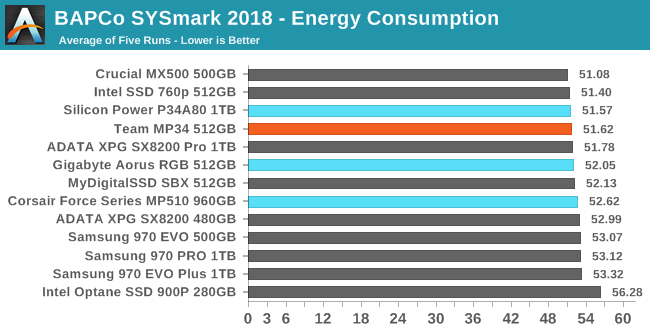
The Team MP34's energy consumption is unsurprisingly lower than the similar drive that has RGB LEDs, but the 1TB Silicon Power P34A80 (another Phison E12 drive) is even a bit more power efficient thanks to its higher performance.
AnandTech Storage Bench - The Destroyer
The Destroyer is an extremely long test replicating the access patterns of very IO-intensive desktop usage. A detailed breakdown can be found in this article. Like real-world usage, the drives do get the occasional break that allows for some background garbage collection and flushing caches, but those idle times are limited to 25ms so that it doesn't take all week to run the test. These AnandTech Storage Bench (ATSB) tests do not involve running the actual applications that generated the workloads, so the scores are relatively insensitive to changes in CPU performance and RAM from our new testbed, but the jump to a newer version of Windows and the newer storage drivers can have an impact.
We quantify performance on this test by reporting the drive's average data throughput, the average latency of the I/O operations, and the total energy used by the drive over the course of the test.
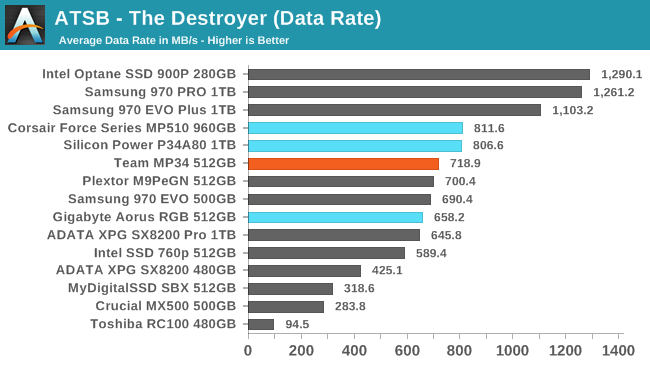
The overall performance of the Team Group MP34 on The Destroyer is the highest we've seen from a 512GB-class drive and a clear improvement over earlier Phison E12 firmware. We haven't tested the latest 500GB TLC drives from Samsung or WD, but even if Phison's latest firmware can't match them it is still competitive. The 1TB Phison E12 drives with older firmware are only about 12% faster overall than the 512GB MP34, so they clearly need to get updated.
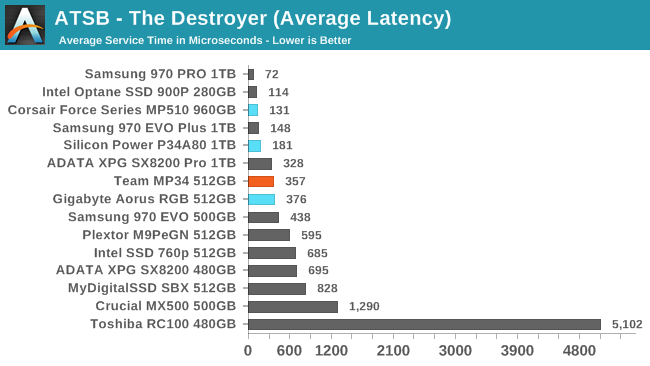
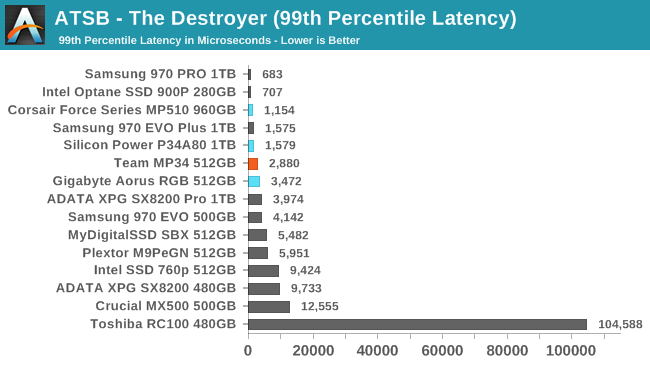
The average and 99th percentile latencies on The Destroyer have both improved slightly for the MP34 compared to the Gigabyte drive with older firmware, but the 1TB class drives still have a larger advantage here than shown on the overall average data rate.
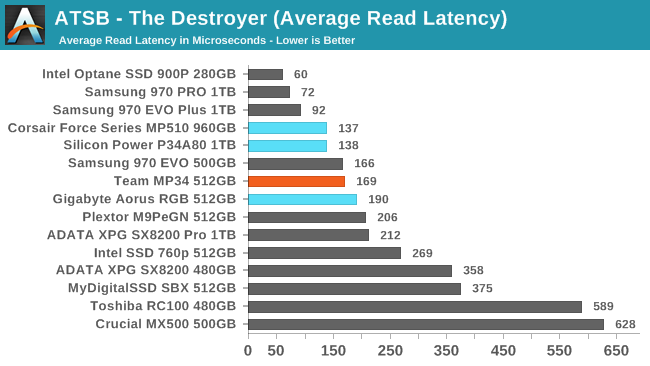
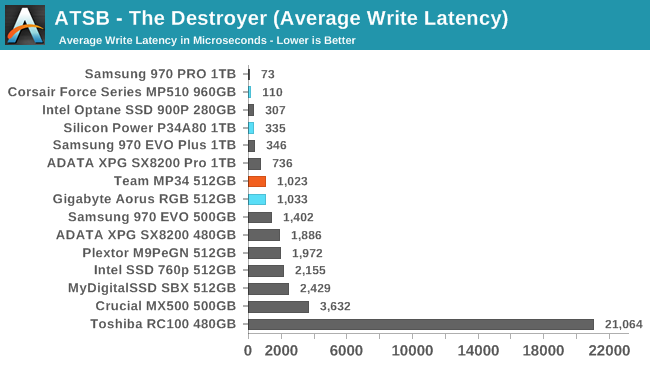
The new Phison E12 12.2 firmware seems to have a bigger impact on average read latencies than average write latencies. The Team MP34 is virtually tied with the Samsung 970 EVO for read latency, and Phison's existing lead in average write latency is barely improved.
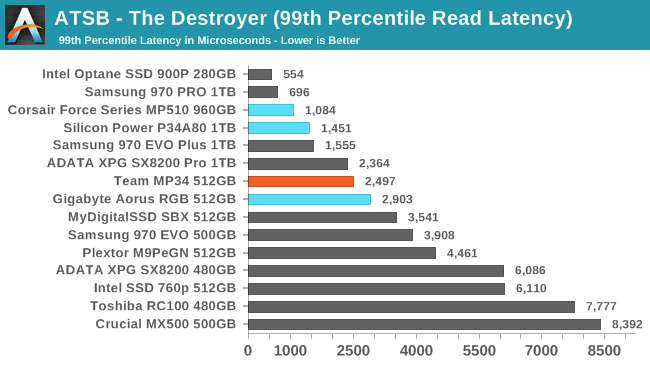
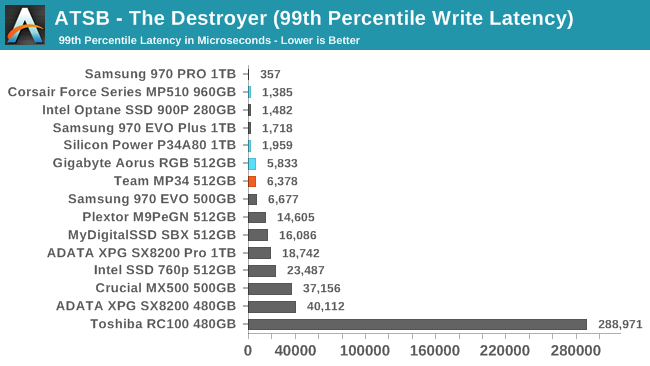
The 99th percentile read and write latency scores show roughly the same effects as the average read and write latencies: the new 12.2 firmware is a real improvement to read latency, but has minimal effect on write latency—not that Phison needed to work on the latter.
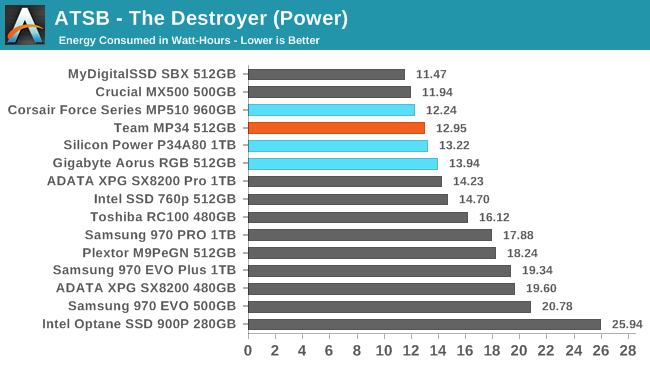
The Team MP34 uses less energy over the course of The Destroyer than any other 512GB-class high-end NVMe drive we've tested, but SATA drives and particularly efficient entry-level NVMe drives are still more efficient overall despite being significantly slower to complete the test.
AnandTech Storage Bench - Heavy
Our Heavy storage benchmark is proportionally more write-heavy than The Destroyer, but much shorter overall. The total writes in the Heavy test aren't enough to fill the drive, so performance never drops down to steady state. This test is far more representative of a power user's day to day usage, and is heavily influenced by the drive's peak performance. The Heavy workload test details can be found here. This test is run twice, once on a freshly erased drive and once after filling the drive with sequential writes.
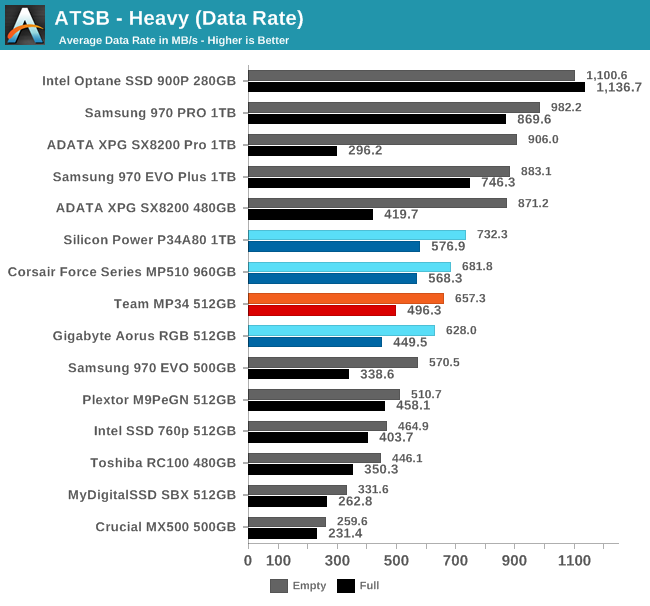
The new firmware that the Team Group MP34 brings leads to small but clear improvements to the average data rate on the Heavy test. This is true for both empty-drive and full-drive test runs, so Phison hasn't made the kind of serious tradeoffs that Silicon Motion did moving from the SM2262 to SM2262EN which has the best peak performance but regressed significantly in worst-case full drive performance.
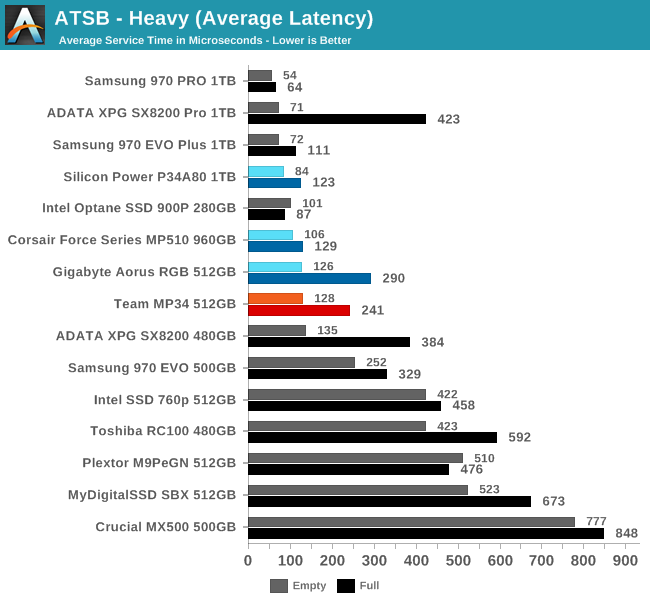
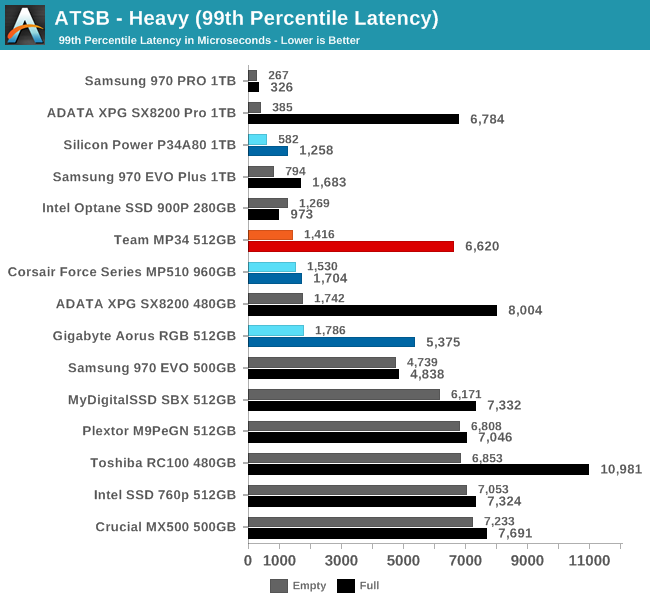
Average latency for the Team MP34 on the Heavy test is basically unchanged when the test is run on an empty drive, but slightly improved for the full-drive test run. The 99th percentile latency scores show the opposite effect: modest improvement for the easier empty-drive test run, but slightly worse for the full-drive test runs. The full-drive QoS is still better than Silicon Motion's drives offer.
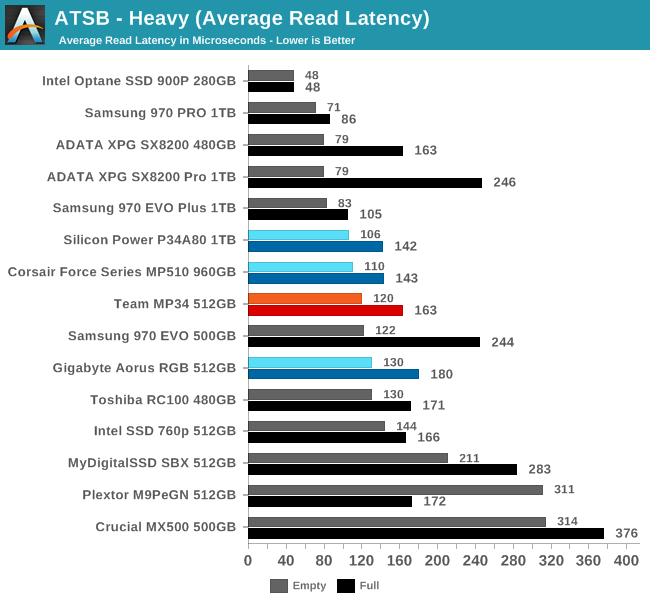
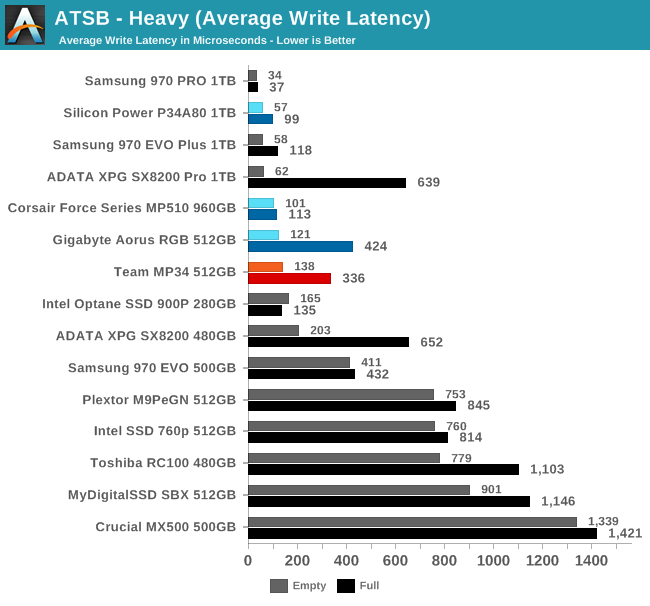
Average read latencies for the MP34 are slightly improved over the old firmware for both empty and full drive test runs, while average write latencies show a slight regression in empty-drive performance in exchange for a larger improvement in full-drive performance.
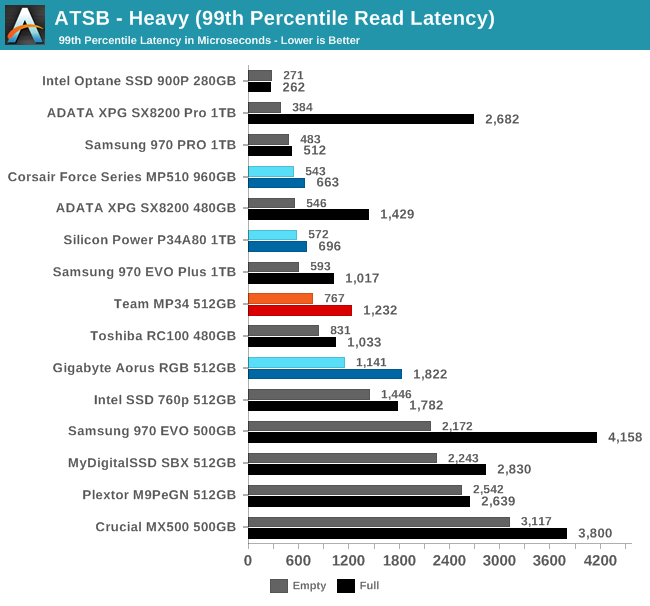
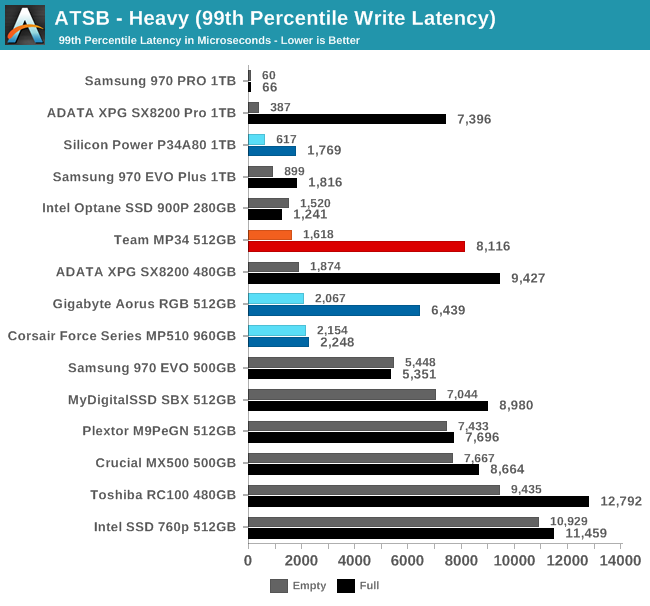
The 99th percentile read latencies for the MP34 on the Heavy test are significantly improved over the older firmware, bringing the 512B MP34's scores closer to most 1TB NVMe drives than to the average 512GB NVMe drive. The changes to 99th percentile write latency are a mixed bag, with empty-drive performance improving slightly but full-drive performance getting worse, and the latter is where the 1TB drives tend to have a big advantage over 512GB drives to begin with.
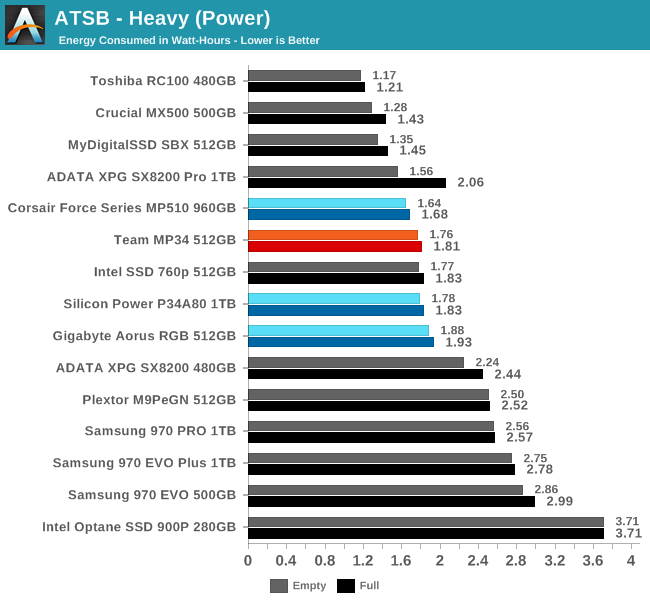
Setting aside the energy usage results for the drive with RGB LEDs, the general power efficiency picture for the Phison E12 hasn't changed much with the new firmware. It's still one of the more efficient high-end NVMe controllers under load, but the entry-level NVMe drives and SATA drives are generally more efficient.
AnandTech Storage Bench - Light
Our Light storage test has relatively more sequential accesses and lower queue depths than The Destroyer or the Heavy test, and it's by far the shortest test overall. It's based largely on applications that aren't highly dependent on storage performance, so this is a test more of application launch times and file load times. This test can be seen as the sum of all the little delays in daily usage, but with the idle times trimmed to 25ms it takes less than half an hour to run. Details of the Light test can be found here. As with the ATSB Heavy test, this test is run with the drive both freshly erased and empty, and after filling the drive with sequential writes.
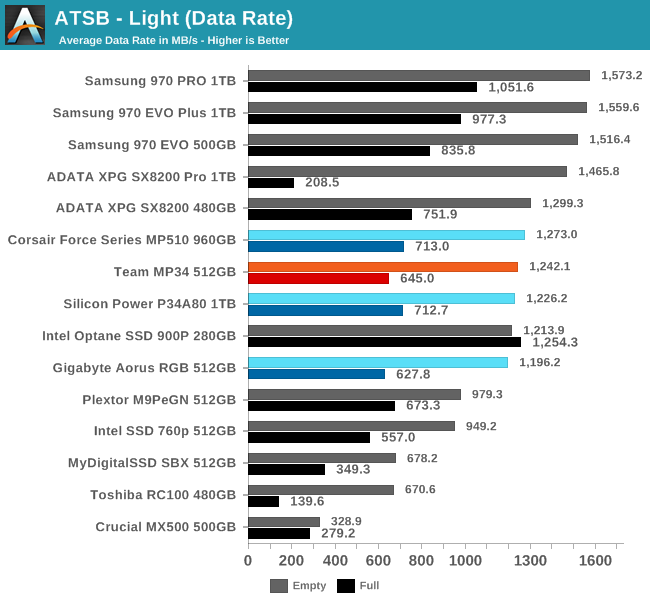
The Light test average data rates don't show any clear improvement from the new firmware used by the Team Group MP34. When the test is run on an empty drive, the overall performance is great for all of the Phison E12 drives we've tested, without much variation between firmware versions or drive capacities. The full drive test runs show a small advantage for the higher-capacity models. Samsung's drives have the highest scores in both cases, and the Silicon Motion SM2262EN provides similar empty-drive performance at the cost of horrible full-drive behavior.
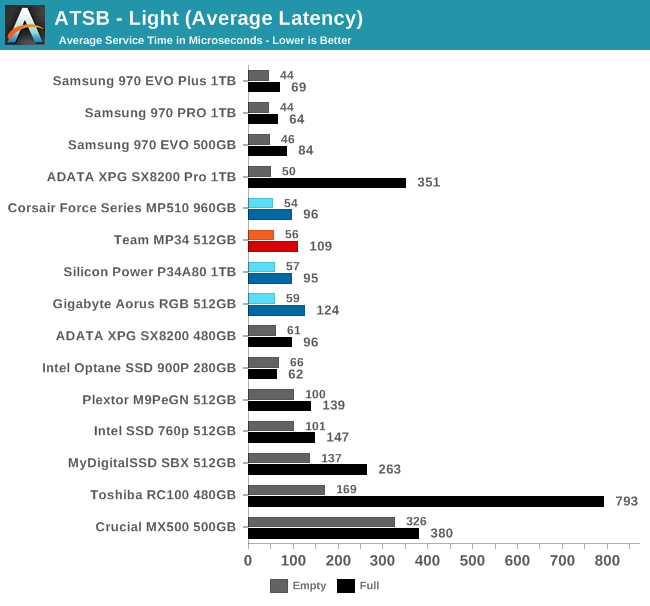
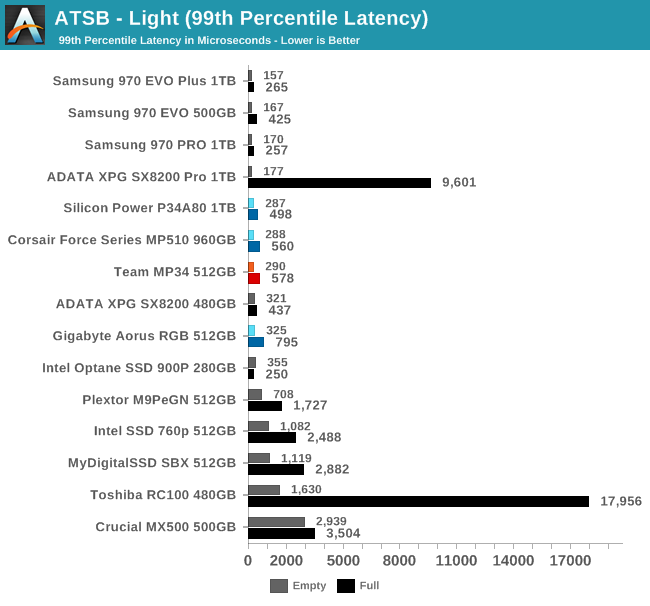
The Team MP34 shows small improvements to both average and 99th percentile latencies compared to the older Phison firmware, but these differences are insignificant compared to those with other hardware: the Phison E12 was already offering great latency by the standards of 512GB drives, and the performance loss when the test is run on a full drive is much less than some of its competition shows.
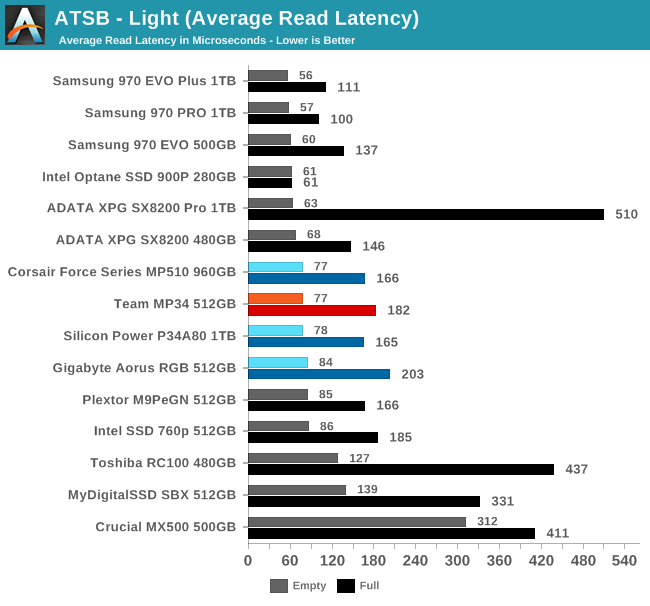
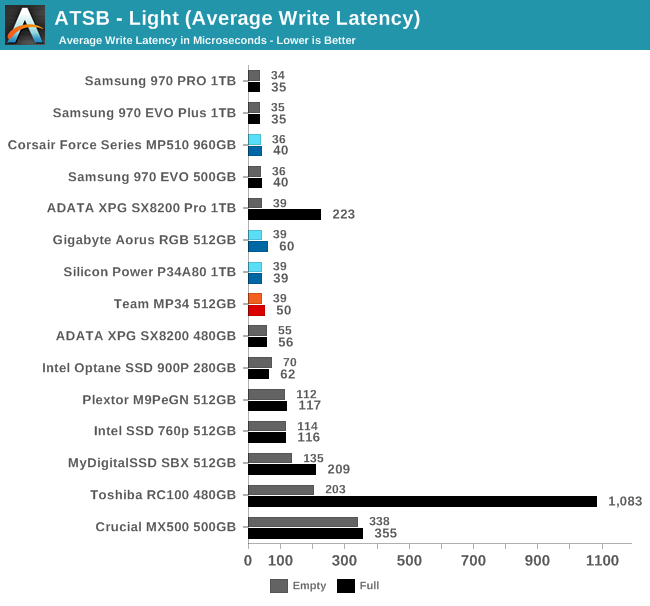
Phison may have improved both average read and write latencies by a few microseconds with their newer firmware used on the MP34, but the changes are insignificant. What is important is that they didn't make anything worse in pursuit of improvements, in contrast to Silicon Motion's SM2262EN.
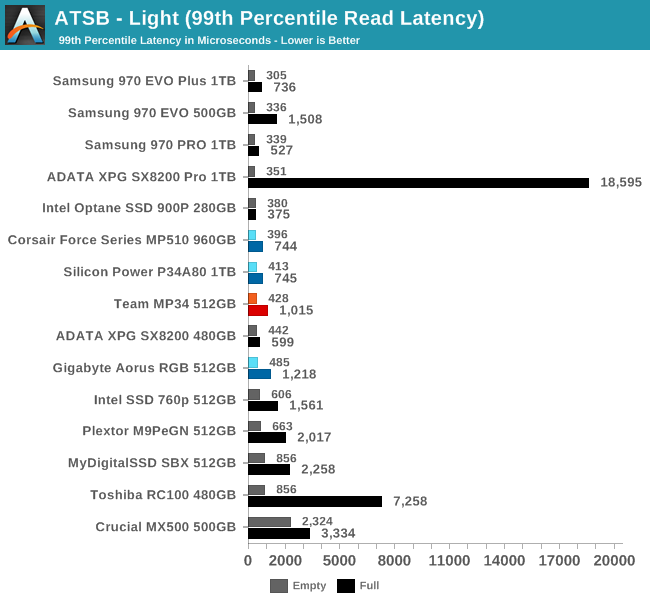
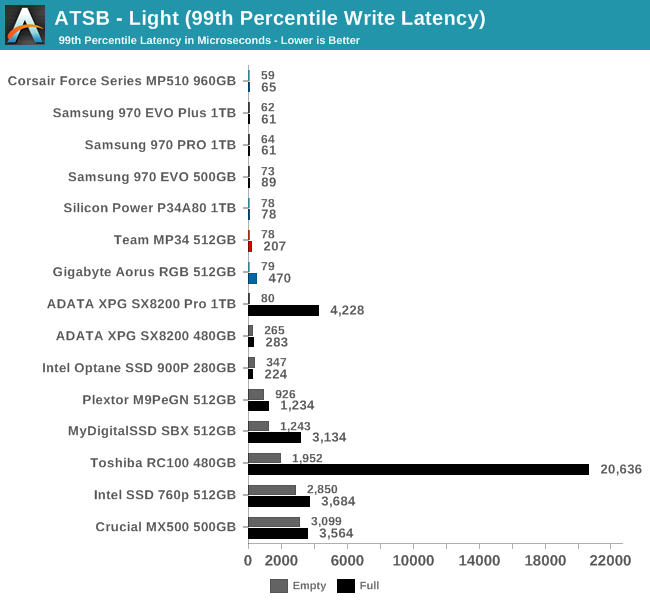
The 99th percentile write latencies for the Team MP34 are a bit better in the full-drive case than the Gigabyte Aorus 512GB, but generally speaking even for these lower capacity drives virtually all of the write operations in the Light test go straight to SLC cache with minimal latency. The 99th percentile read latency is also slightly improved, with almost all read operations completed in under 1ms even when the test is run on a full drive.
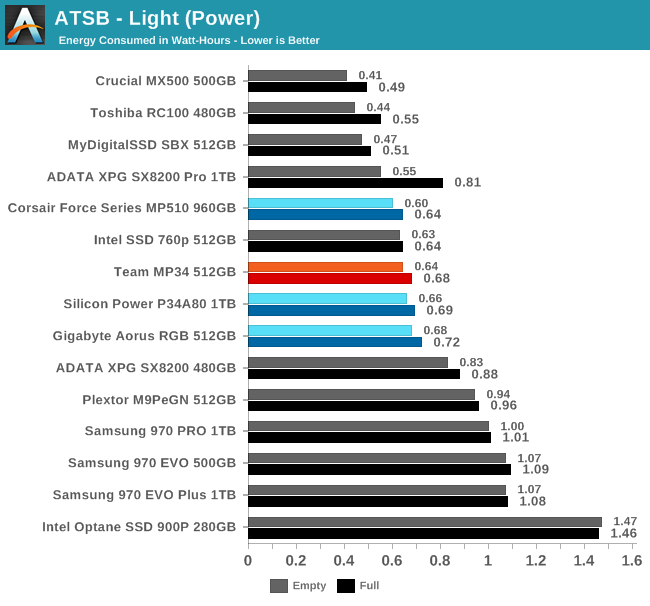
The Team MP34 and other Phison E12 drives use less energy over the course of the Light test than Samsung's drives and several other high-end NVMe drives, but ADATA's SX8200 Pro comes out ahead of the Phison drives when the test is run on an empty drive. For this test, even the entry-level NVMe drives require more energy than the Crucial MX500 SATA SSD.
Random Read Performance
Our first test of random read performance uses very short bursts of operations issued one at a time with no queuing. The drives are given enough idle time between bursts to yield an overall duty cycle of 20%, so thermal throttling is impossible. Each burst consists of a total of 32MB of 4kB random reads, from a 16GB span of the disk. The total data read is 1GB.
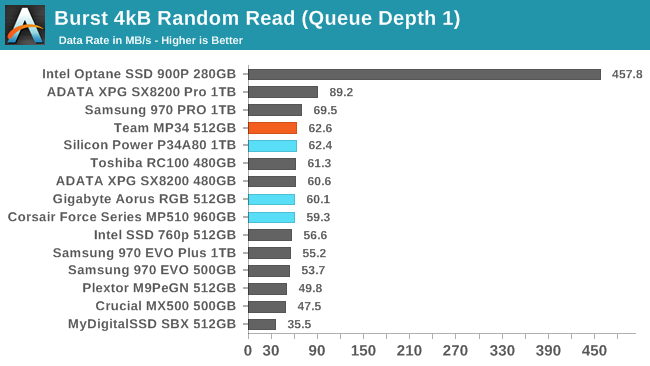
The QD1 burst random read performance of the Team MP34 is higher than previous Phison E12 drives of any capacity, but it's a pretty small improvement. We haven't seen a higher score from any other 512GB-class drive, but that's probably because we have not yet tested a 512GB-class Silicon Motion SM2262EN drive with Micron NAND; that combination has a big lead among 1TB drives.
Our sustained random read performance is similar to the random read test from our 2015 test suite: queue depths from 1 to 32 are tested, and the average performance and power efficiency across QD1, QD2 and QD4 are reported as the primary scores. Each queue depth is tested for one minute or 32GB of data transferred, whichever is shorter. After each queue depth is tested, the drive is given up to one minute to cool off so that the higher queue depths are unlikely to be affected by accumulated heat build-up. The individual read operations are again 4kB, and cover a 64GB span of the drive.
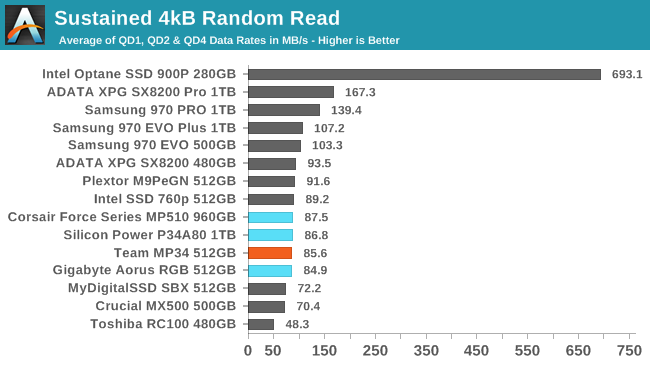
On the longer random read test, the Team MP34 and other Phison E12 drives fall even further behind the fastest TLC drives, but still have a clear performance advantage over the SATA entry-level NVMe drives.
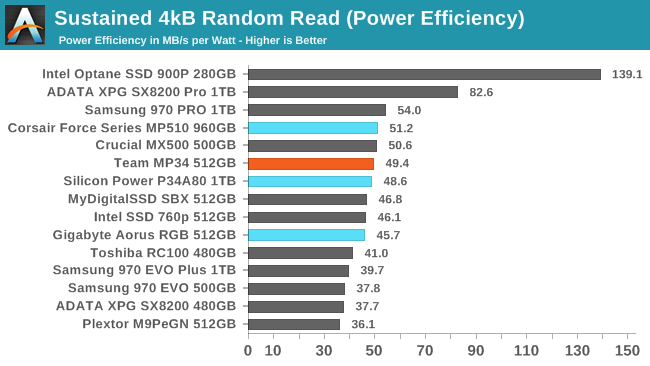 |
|||||||||
| Power Efficiency in MB/s/W | Average Power in W | ||||||||
The Team MP34 and other Phison E12 drives have good power efficiency on the random read test, comparable to the SATA drive and the better entry-level NVMe drives. But the Silicon Motion SM2262EN drives stand above the rest, requiring only a bit more power than the E12 and providing significantly better performance.
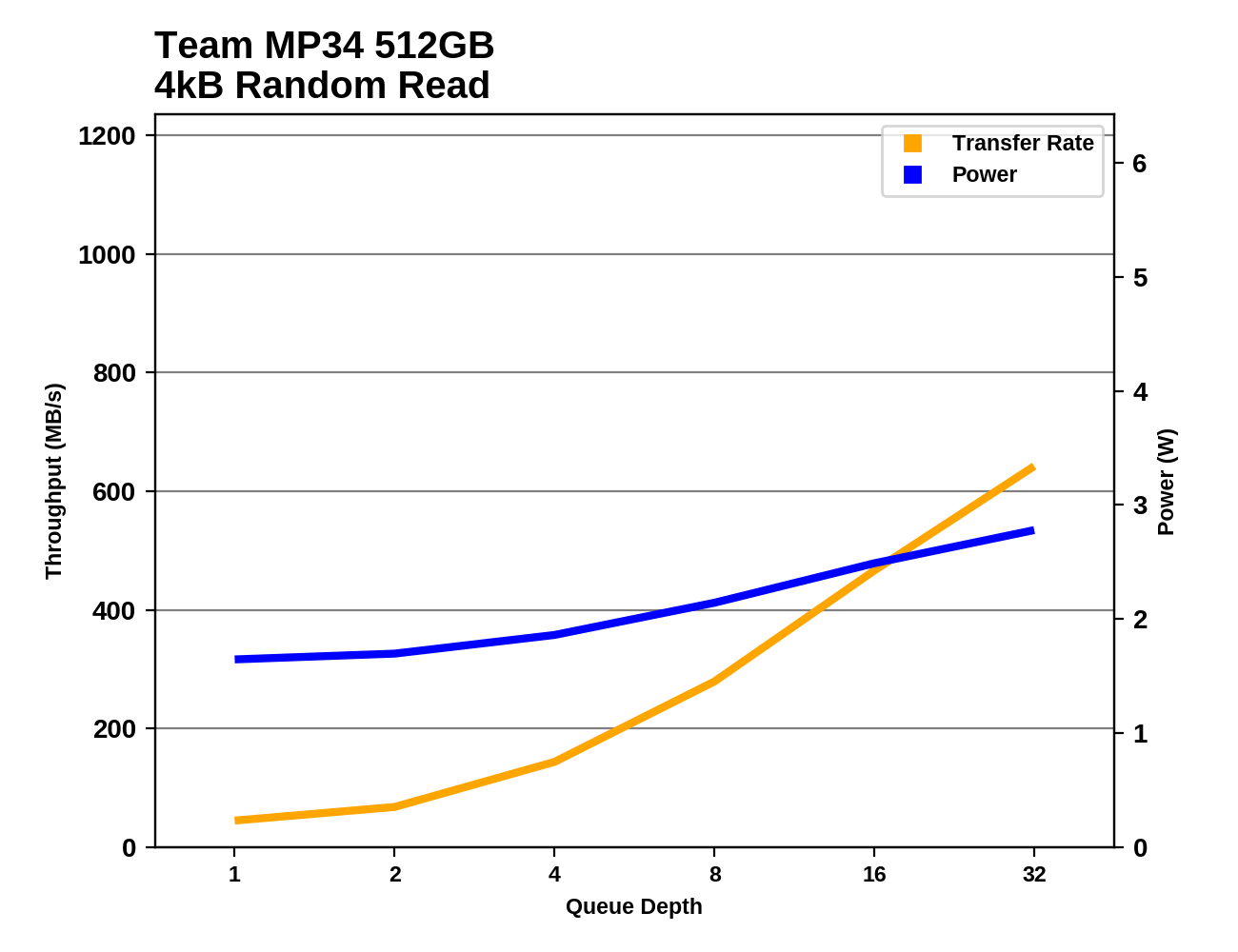 |
|||||||||
At higher queue depths, the 512GB MP34 provides equal or better performance to the other drives of similar capacity that we have tested. Most of the 1TB drives are significantly faster at those queue depths, and it is likely that the ADATA SX8200 Pro's lead carries over to the smaller models that we have not had the opportunity to test.
At lower queue depths where the Team MP34 is still delivering performance within reach of SATA drives, its efficiency is nothing special—plenty of those SATA drives can perform the same while using much less power. Once the MP34's performance scales beyond the SATA limit, there are only a handful of drives that offer similar performance for less power. However, there are also numerous options that hit much higher speeds while consuming basically the same power as the MP34 at QD32.
Random Write Performance
Our test of random write burst performance is structured similarly to the random read burst test, but each burst is only 4MB and the total test length is 128MB. The 4kB random write operations are distributed over a 16GB span of the drive, and the operations are issued one at a time with no queuing.
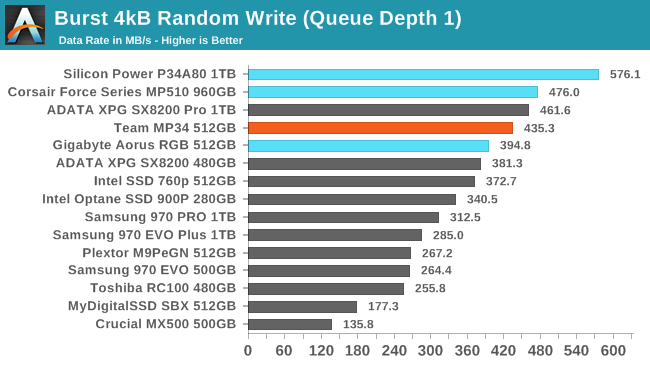
Phison's SLC write cache was already one of the fastest on the market, and the new firmware used by the Team MP34 improves burst random write performance by another 10%. The 512GB MP34's burst write performance is better than most 1TB high end drives.
As with the sustained random read test, our sustained 4kB random write test runs for up to one minute or 32GB per queue depth, covering a 64GB span of the drive and giving the drive up to 1 minute of idle time between queue depths to allow for write caches to be flushed and for the drive to cool down.
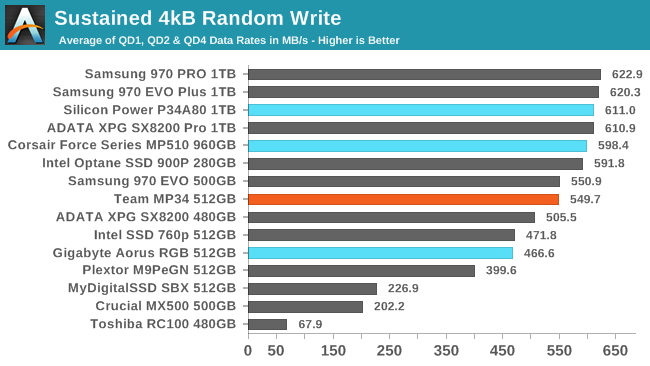
On the longer random write performance, the larger drives are unavoidably faster. But the new firmware in the Team MP34 brings its performance up to the level of the Samsung 970 EVO, a more significant increase than for the burst write speed.
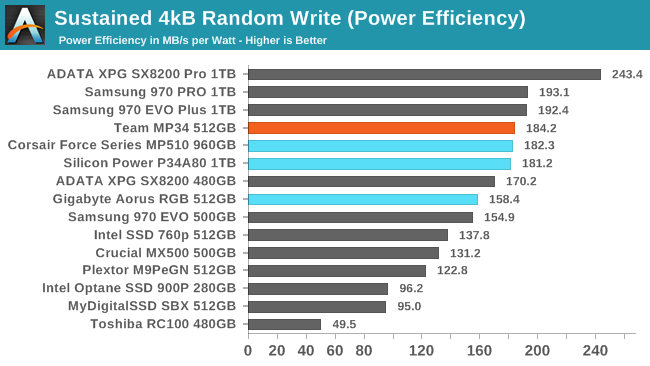 |
|||||||||
| Power Efficiency in MB/s/W | Average Power in W | ||||||||
The improved performance of the MP34 over the Gigabyte drive with older firmware brings power efficiency on the random write test up to the level of the faster 1TB drives. The MP34 draws very slightly more power than the Gigabyte Aorus despite the latter's RGB LEDs, but the MP34's extra power is well-spent.
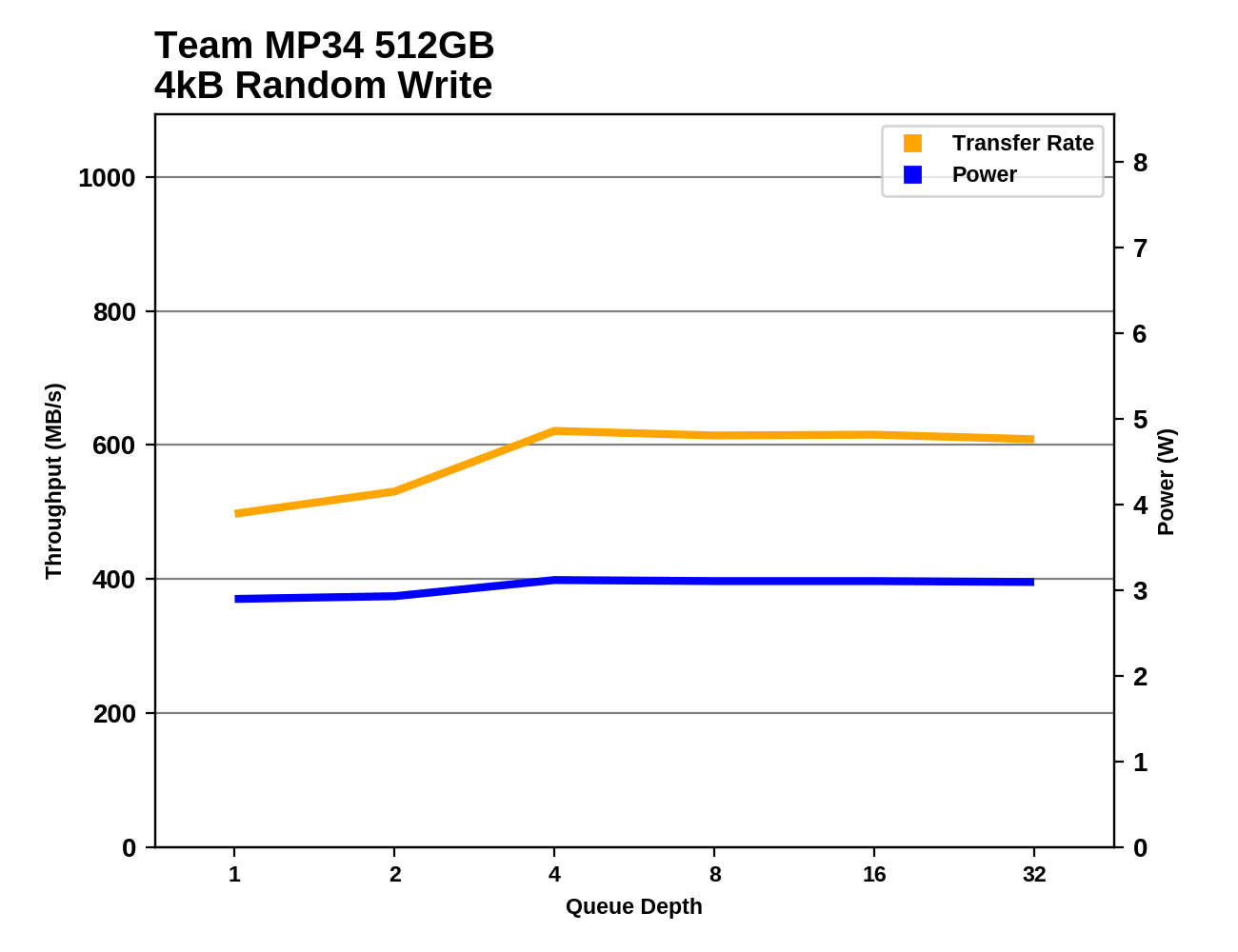 |
|||||||||
The Team MP34 is provides faster random writes than the Gigabyte Aorus RGB at all tested queue depths, and generally uses about the same power. Full performance is reached at QD4, which is typical for most drives.
The Team MP34's performance on the random write test is well above SATA territory but the modest capacity prevents it from reaching the high speeds that 1+TB drives hit. Power efficiency is decent, but there are a handful of drives that can write to their SLC caches at similar speeds with significantly lower power.
Sequential Read Performance
Our first test of sequential read performance uses short bursts of 128MB, issued as 128kB operations with no queuing. The test averages performance across eight bursts for a total of 1GB of data transferred from a drive containing 16GB of data. Between each burst the drive is given enough idle time to keep the overall duty cycle at 20%.
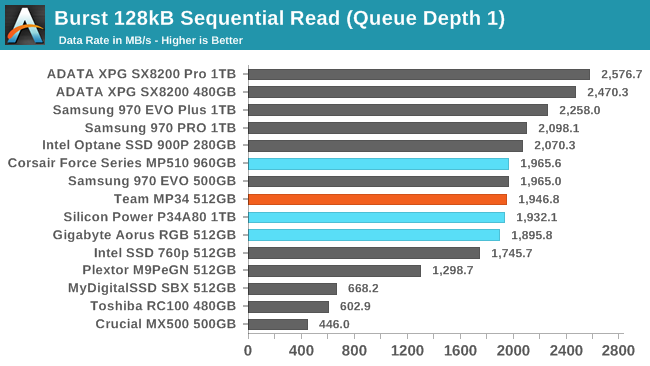
The Team Group MP34's newer firmware brings a few percent improvement to the burst sequential read speed, but the Phison E12 drives are all still stuck below 2GB/s while Silicon Motion SM2262(EN) drives are around 2.5GB/s at QD1.
Our test of sustained sequential reads uses queue depths from 1 to 32, with the performance and power scores computed as the average of QD1, QD2 and QD4. Each queue depth is tested for up to one minute or 32GB transferred, from a drive containing 64GB of data. This test is run twice: once with the drive prepared by sequentially writing the test data, and again after the random write test has mixed things up, causing fragmentation inside the SSD that isn't visible to the OS. These two scores represent the two extremes of how the drive would perform under real-world usage, where wear leveling and modifications to some existing data will create some internal fragmentation that degrades performance, but usually not to the extent shown here.
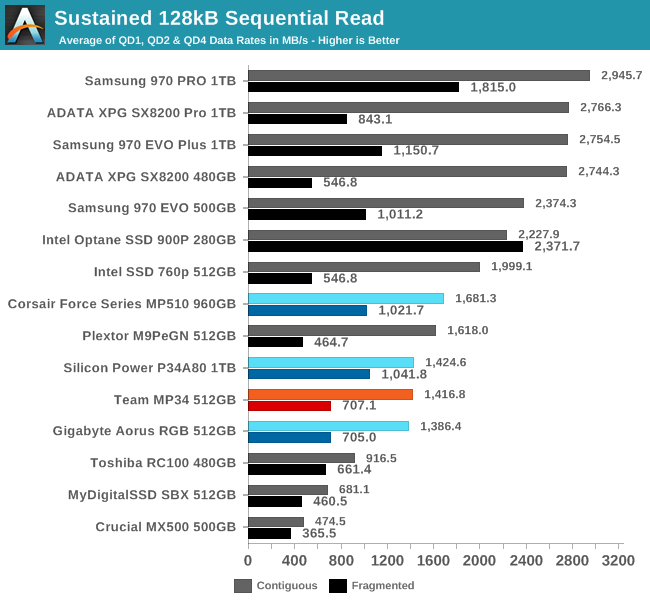
On the longer sequential read test, the Phison E12 drives including the Team MP34 are all at a clear disadvantage to the Samsung or Silicon Motion based competition. However, in the worst case scenario of reading data that was written as random writes, the MP34 performs reasonably well: ahead of the Silicon Motion drives but still slower than Samsung.
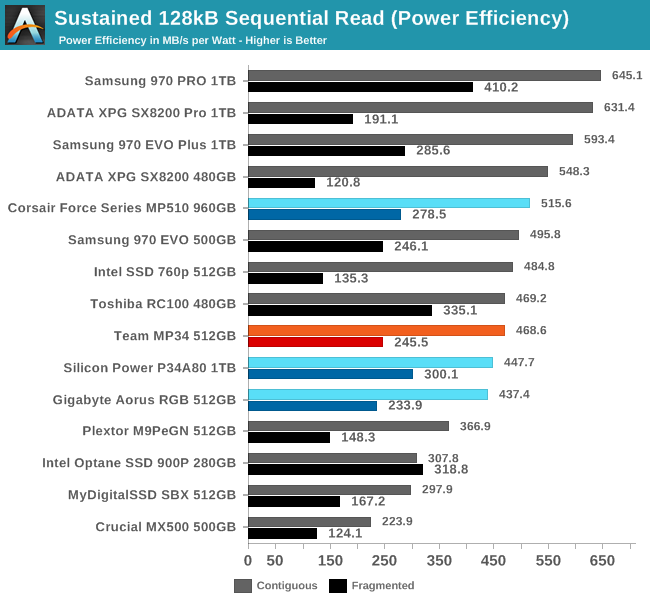 |
|||||||||
| Power Efficiency in MB/s/W | Average Power in W | ||||||||
The power efficiency of the Team MP34 is naturally better than the Gigabyte Aorus SSD with RGB LEDs, and it is almost tied with the Samsung 970 EVO 500GB. In absolute terms, the power draw by the MP34 during the sequential read test was lower than any other high-end NVMe SSD, but still clearly higher than SATA and entry-level NVMe drives.
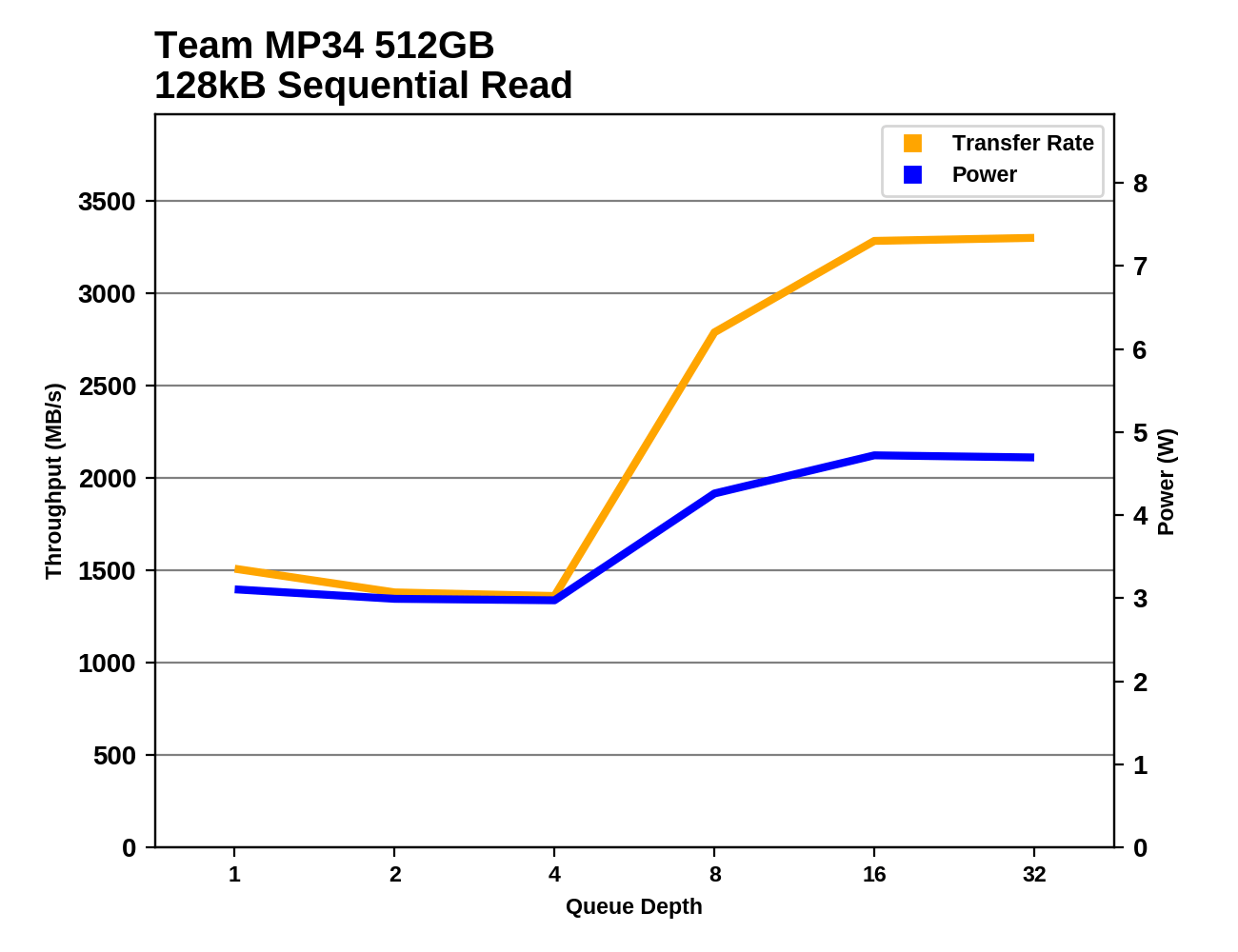 |
|||||||||
Like other Phison E12 drives, the Team MP34 is hurt by sequential read performance that stays basically flat until queue depths increase beyond QD4, and our scores above focus specifically on low queue depths. At sufficiently high queue depths, the MP34 reaches reasonable speeds for a high-end drive.
The sequential read speeds from the Team MP34 span a wide range of speeds, depending on queue depth. At low and high queue depths, it operates with reasonable efficiency, but for low queue depths there are several entry-level NVMe drives that offer better efficiency for similar or better speeds.
Sequential Write Performance
Our test of sequential write burst performance is structured identically to the sequential read burst performance test save for the direction of the data transfer. Each burst writes 128MB as 128kB operations issued at QD1, for a total of 1GB of data written to a drive containing 16GB of data.
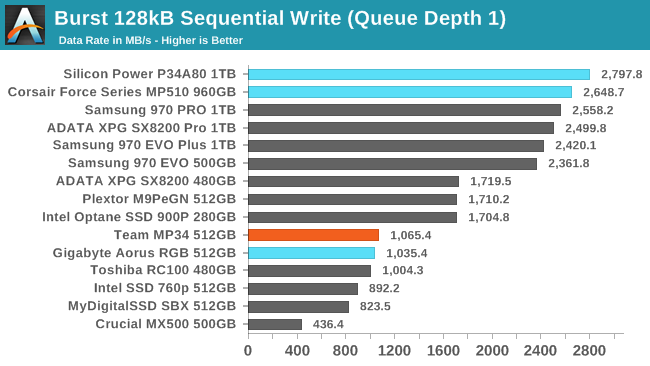
The 1TB Phison E12 drives have some of the best scores on our burst sequential write test, but the 512GB drives like the Team MP34 offer less than half of the performance. The MP34 manages just over 1GB/s while the Plextor M9Pe hits 1.7GB/s with the same NAND and the 500GB Samsung 970EVO is well over 2GB/s.
Our test of sustained sequential writes is structured identically to our sustained sequential read test, save for the direction of the data transfers. Queue depths range from 1 to 32 and each queue depth is tested for up to one minute or 32GB, followed by up to one minute of idle time for the drive to cool off and perform garbage collection. The test is confined to a 64GB span of the drive.
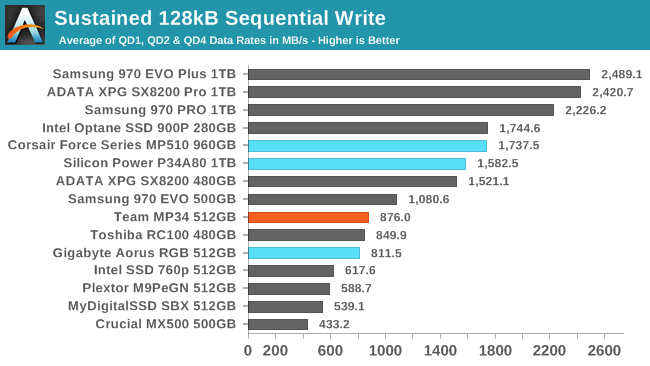
On the longer sequential write test, there are fewer 512GB-class drives that beat the Team MP34, but the Samsung and Silicon Motion drives both manage to do so by a wide margin. As with the burst sequential write performance, the MP34's newer firmware gives it only a tiny advantage over the Gigabyte drive with older firmware.
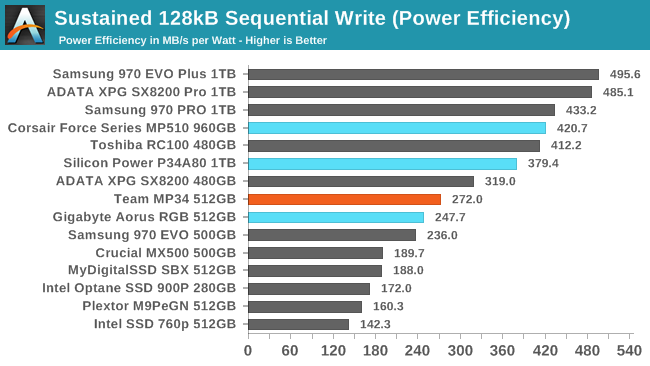 |
|||||||||
| Power Efficiency in MB/s/W | Average Power in W | ||||||||
The power efficiency of the Team MP34 on the sustained sequential write test is pretty good for a 512GB-class drive, but pales in comparison to what the good 1TB drives offer. As usual, the MP34 is the least power-hungry high-end NVMe drive in this bunch, but in this case its performance isn't quite up to high-end standards.
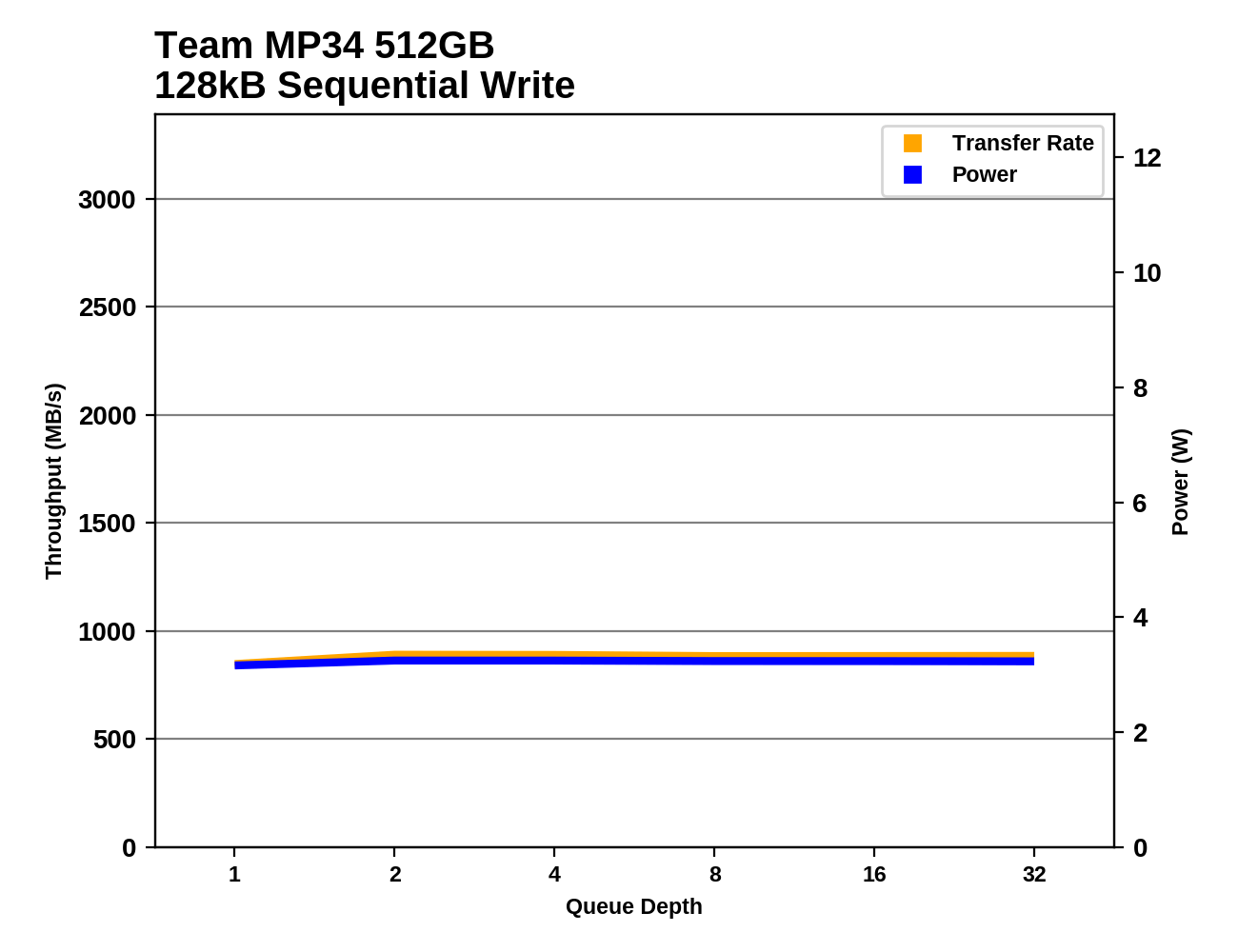 |
|||||||||
As with most drives on this test, the Team MP34's performance doesn't vary with capacity. The 1TB Phison E12 drives and a few others show variable performance because they are sometimes able to complete most or all of one of the test phases using just their SLC cache, but the SLC cache on the 512GB MP34 is too small for this test.
The sequential write performance of the Team MP34 is well above SATA levels and power efficiency is about average for the speeds it attains, but larger NVMe drives can provide vastly higher write speeds.
Mixed Random Performance
Our test of mixed random reads and writes covers mixes varying from pure reads to pure writes at 10% increments. Each mix is tested for up to 1 minute or 32GB of data transferred. The test is conducted with a queue depth of 4, and is limited to a 64GB span of the drive. In between each mix, the drive is given idle time of up to one minute so that the overall duty cycle is 50%.
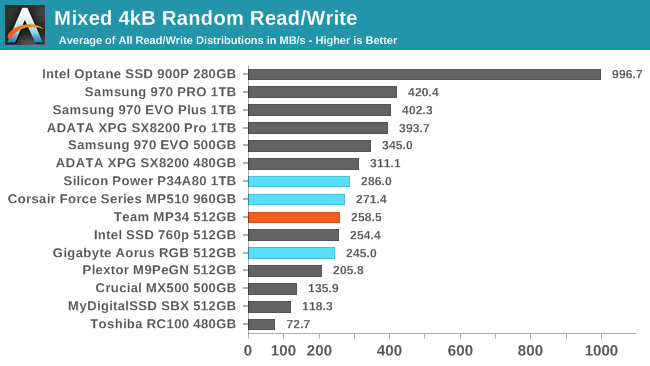
The newer firmware on the Team Group MP34 gives it a slight edge over the Gigabyte Aorus RGB SSD, but both drives are significantly slower overall on the mixed random IO test than the fastest 512GB-class drives we have tested. The Samsung and Silicon Motion based competitors are even outperforming the higher-capacity Phison E12 drives.
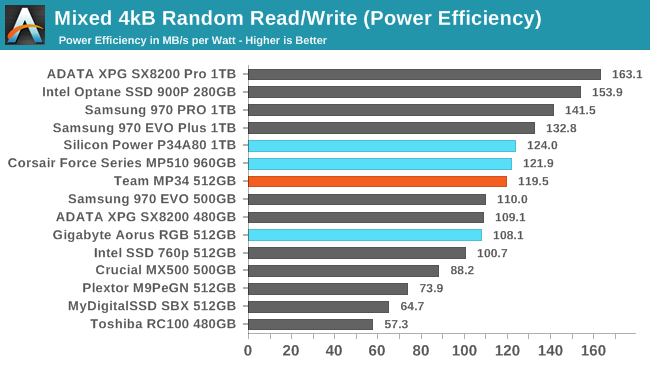 |
|||||||||
| Power Efficiency in MB/s/W | Average Power in W | ||||||||
The Team MP34's power efficiency during the mixed random IO test is a bit lower than the 1TB Phison E12 drives, but it's clearly more efficient that all the other 512GB-class drives in this bunch. The Gigabyte Aorus SSD's lower efficiency is no surprise given the RGB LEDs, but it actually still draws less power than the Samsung and ADATA drives.
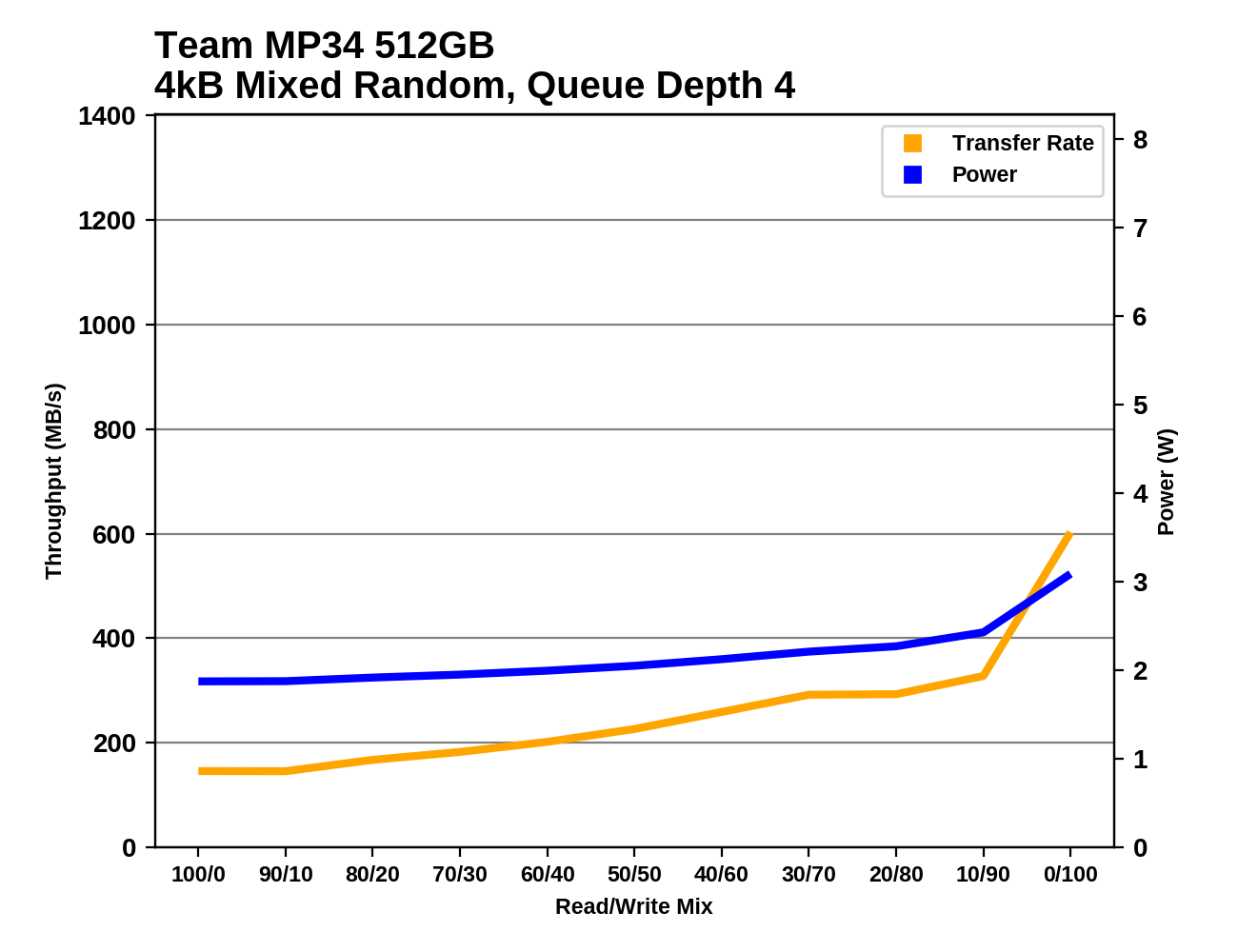 |
|||||||||
The Team MP34 has generally the same performance profile as the earlier Phison E12 drives, but it performs a bit better than the earlier firmware during the more write-heavy half of the test. The only large difference in performance is at the very end of the test, where the pure random write speed of the MP34 is a clear improvement over the Gigabyte Aorus. The competitors that offer much better overall performance have small advantages during the read-heavy portions of the test and build up a larger lead over the MP34 in the write-heavy half.
Mixed Sequential Performance
Our test of mixed sequential reads and writes differs from the mixed random I/O test by performing 128kB sequential accesses rather than 4kB accesses at random locations, and the sequential test is conducted at queue depth 1. The range of mixes tested is the same, and the timing and limits on data transfers are also the same as above.
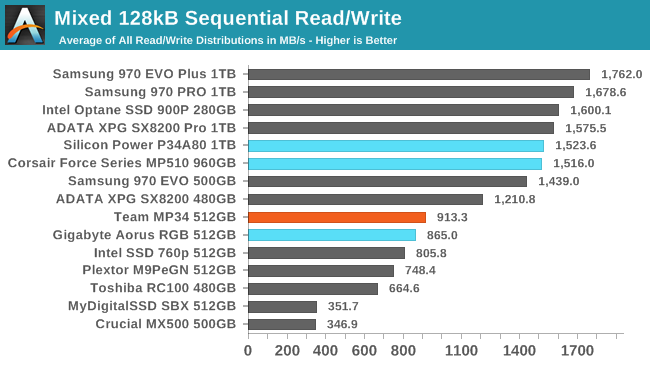
Drive capacity is obviously the primary factor affecting overall performance on the mixed sequential IO test, with all of the 1TB class drives outperforming all of the 512GB class drives. The 500GB Samsung 970 EVO comes very close to matching the performance of some 1TB drives, and the ADATA SX8200 is not too far behind, but the Team MP34 doesn't get close and is only slightly faster than the drive with older Phison E12 firmware.
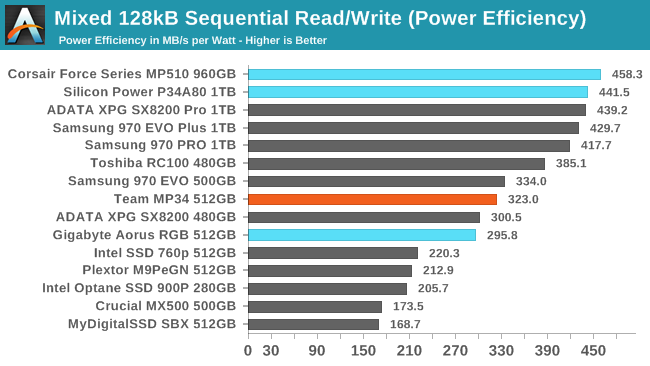 |
|||||||||
| Power Efficiency in MB/s/W | Average Power in W | ||||||||
The Team MP34 provides competitive power efficiency for its capacity class when running the mixed sequential IO test. The 500GB Samsung 970 EVO is a bit more efficient, drawing much more power but also offering much more performance. The Toshiba RC100 entry-level NVMe drive provides the best efficiency in this capacity class, because it uses less power on average than even the Crucial MX500 SATA drive.
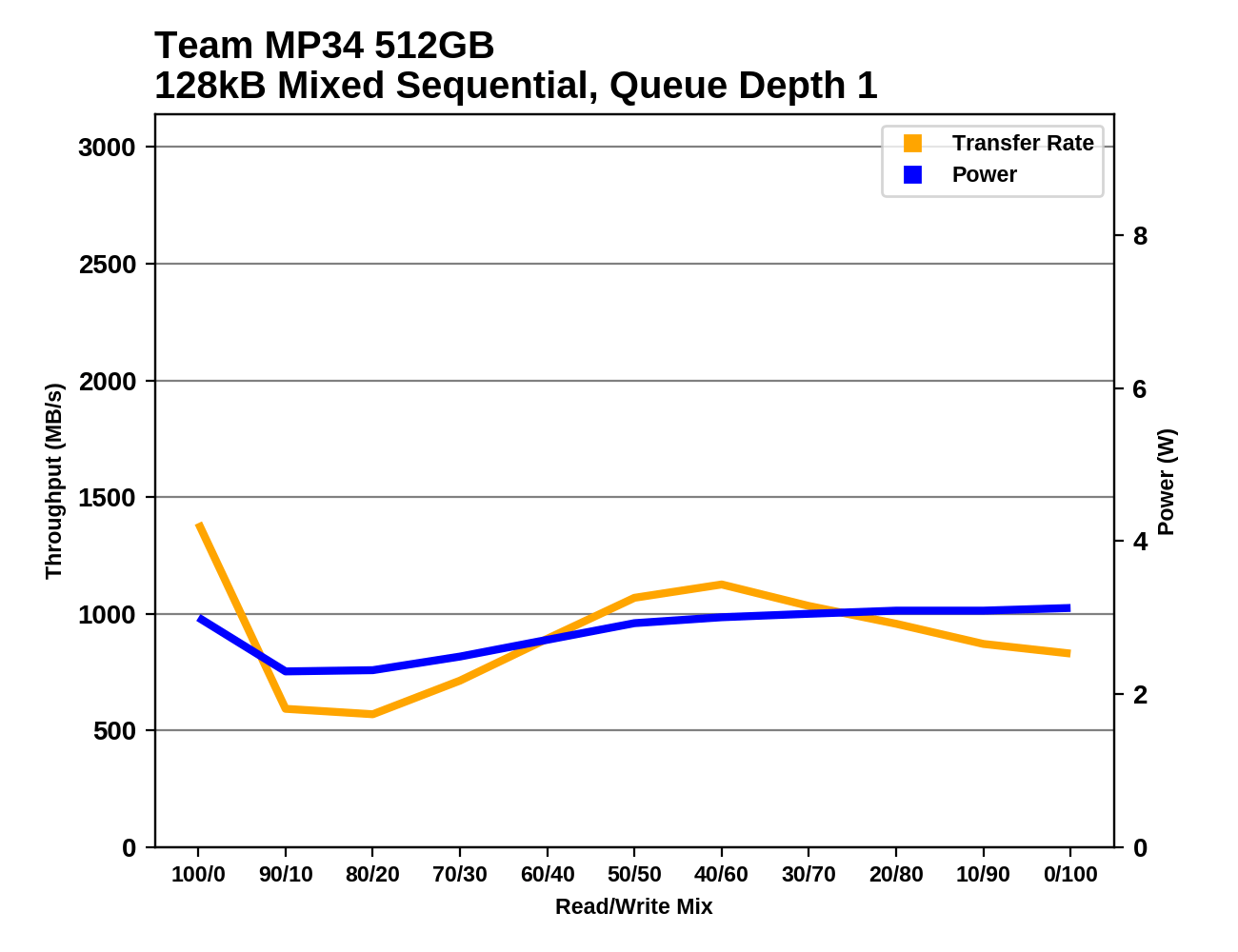 |
|||||||||
The performance of the Team MP34 wobbles around as the workload shifts from mostly reads to mostly writes, but this is the same basic pattern we saw with the Gigabyte Aorus SSD, though the MP34's newer firmware brings slight improvements to the more write-heavy phases of the test. Overall, the MP34's performance is sub-par for the most read-heavy tests, but it holds up reasonably well against the competition during the more write-heavy parts of the test.
Power Management Features
Real-world client storage workloads leave SSDs idle most of the time, so the active power measurements presented earlier in this review only account for a small part of what determines a drive's suitability for battery-powered use. Especially under light use, the power efficiency of a SSD is determined mostly be how well it can save power when idle.
For many NVMe SSDs, the closely related matter of thermal management can also be important. M.2 SSDs can concentrate a lot of power in a very small space. They may also be used in locations with high ambient temperatures and poor cooling, such as tucked under a GPU on a desktop motherboard, or in a poorly-ventilated notebook.
| Team Group MP34 512GB NVMe Power and Thermal Management Features |
|||
| Controller | Phison PS5012-E12 | ||
| Firmware | ECFM12.2 | ||
| NVMe Version |
Feature | Status | |
| 1.0 | Number of operational (active) power states | 3 | |
| 1.1 | Number of non-operational (idle) power states | 2 | |
| Autonomous Power State Transition (APST) | Supported | ||
| 1.2 | Warning Temperature | 70 °C | |
| Critical Temperature | 90 °C | ||
| 1.3 | Host Controlled Thermal Management | Supported | |
| Non-Operational Power State Permissive Mode | Not Supported | ||
The new 12.2 firmware for the Phison E12 doesn't bring any change to the list of supported power management features. The maximum power draw declared by the MP34 for each of its three active power states is actually a few mW higher than what the Gigabyte Aorus RGB claims, but other than this the power state table hasn't been tweaked.
| Team Group MP34 512GB NVMe Power States |
|||||
| Controller | Phison PS5012-E12 | ||||
| Firmware | ECFM12.2 | ||||
| Power State |
Maximum Power |
Active/Idle | Entry Latency |
Exit Latency |
|
| PS 0 | 8.12 W | Active | - | - | |
| PS 1 | 6.40 W | Active | - | - | |
| PS 2 | 5.54 W | Active | - | - | |
| PS 3 | 49 mW | Idle | 2 ms | 2 ms | |
| PS 4 | 1.8 W | Idle | 25 ms | 25 ms | |
Note that the above tables reflect only the information provided by the drive to the OS. The power and latency numbers are often very conservative estimates, but they are what the OS uses to determine which idle states to use and how long to wait before dropping to a deeper idle state.
Idle Power Measurement
SATA SSDs are tested with SATA link power management disabled to measure their active idle power draw, and with it enabled for the deeper idle power consumption score and the idle wake-up latency test. Our testbed, like any ordinary desktop system, cannot trigger the deepest DevSleep idle state.
Idle power management for NVMe SSDs is far more complicated than for SATA SSDs. NVMe SSDs can support several different idle power states, and through the Autonomous Power State Transition (APST) feature the operating system can set a drive's policy for when to drop down to a lower power state. There is typically a tradeoff in that lower-power states take longer to enter and wake up from, so the choice about what power states to use may differ for desktop and notebooks, and depending on which NVMe driver is in use. Additionally, there are multiple degrees of PCIe link power savings possible through Active State Power Management (APSM).
We report three idle power measurements. Active idle is representative of a typical desktop, where none of the advanced PCIe link or NVMe power saving features are enabled and the drive is immediately ready to process new commands. Our Desktop Idle number represents what can usually be expected from a desktop system that is configured to enable SATA link power management, PCIe ASPM and NVMe APST, but where the lowest PCIe L1.2 link power states are not available. The Laptop Idle number represents the maximum power savings possible with all the NVMe and PCIe power management features in use—usually the default for a battery-powered system but rarely achievable on a desktop even after changing BIOS and OS settings. Since we don't have a way to enable SATA DevSleep on any of our testbeds, SATA drives are omitted from the Laptop Idle charts.
Note: We recently upgraded our power measurement equipment and switched to measuring idle power on our Coffee Lake desktop, our first SSD testbed to have fully-functional PCIe power management. The below measurements are all new this month, and are not a perfect match for the older measurements in our previous reviews and the Bench database.
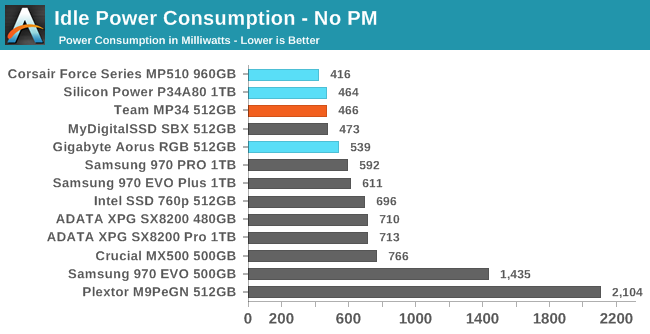
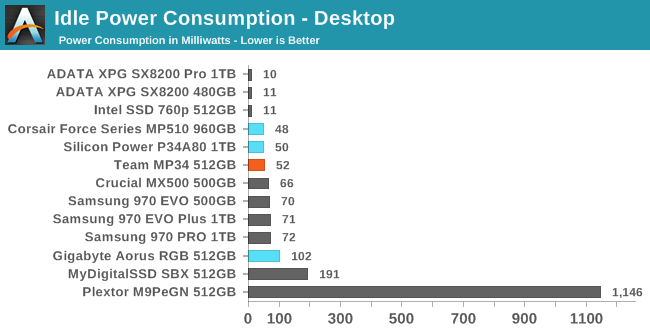
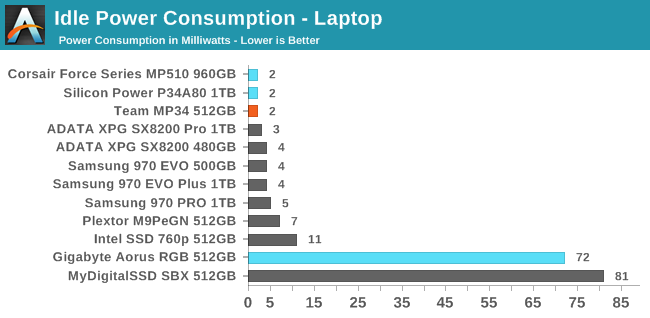
The Phison E12 controller continues to have pretty good power management. The active idle power consumption and the deepest laptop idle power states are best in class, but Silicon Motion's SM2262(EN) controllers can usually reach a deeper idle power level on most desktops.
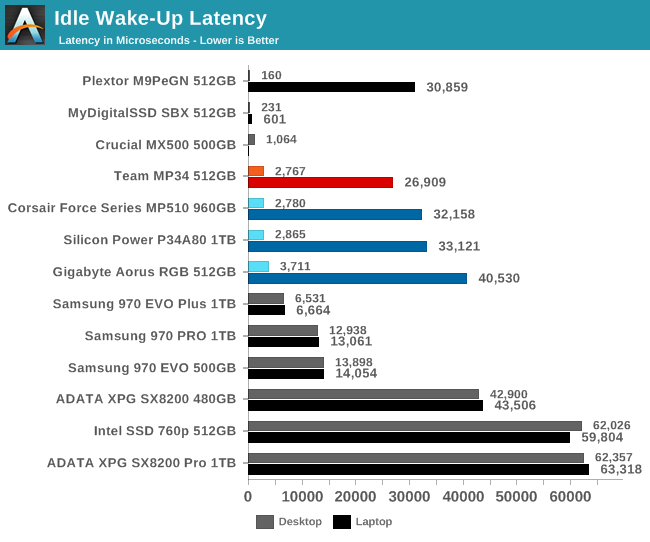
The idle wake-up latencies measured from the Phison E12 drives including the Team MP34 are pretty close to what the drive promises to the OS. The desktop idle state corresponds to the drives NVMe Power State 3, and the laptop idle is the drive's Power State 4. Most of the other controllers take about the same amount of time to wake up from either the desktop or laptop idle states, indicating that they aren't smart enough to disable their deepest (slowest) idle power state when the requisite PCIe link states are unavailable. This leaves the Silicon Motion drives in particular at a potential disadvantage on a desktop that's configured to use some power savings.
Conclusion
The hardware in the Team Group's MP34 SSD is nothing new; plenty of other brands have been selling basically the same drive for months. What's interesting about the MP34 is the newer firmware it uses for the Phison E12 controller. Some other brands have been slower to start shipping Phison's firmware updates, and many fail to offer the updates for drives that have already been sold. This is a shame, because the Team MP34 shows that Phison has continued to refine their firmware, bringing modest performance improvements with no significant sacrifices. Phison tends to offer more post-launch firmware updates than most other controller vendors. For their first generation NVMe controller, this was a necessity to remedy obvious shortcomings, but for the Phison E12 controller this continuing support is just icing on the cake.
There are only a handful of cases where the we see other drives achieving better performance out of the same Toshiba/SanDisk 3D TLC, though we expect we'd see a few more if we had the chance to test the 500GB WD Black SN750. Overall, Phison is doing a good job of handling the NAND they're working with, and the cases where their drives fall behind seem to be more often due to shortcomings with the NAND itself than with Phison's controller or firmware. Phison provides firmware to use their recent controllers with Micron NAND instead of Toshiba/SanDisk, but for this generation almost nobody is using that option. This is likely to change with their next generation of controllers, and there will probably be much more diversity among Phison E16 drives than among Phison E12 drives.
The Phison E12 is now well-established as a solid platform that can handle heavy workloads with no trouble. It doesn't set benchmark records, but it provides great performance even under adverse conditions. And for mobile users, it has employs solid power management techniques and doesn't burn a lot of power trying to be the absolute fastest.
| High-End NVMe SSD Price Comparison (May 15, 2019) |
|||||||
| 240-280GB | 480-512GB | 960GB-1TB | 2TB | ||||
| Team Group MP34 | $41.99 (16¢/GB) | $74.99 (15¢/GB) | $159.99 (16¢/GB) | ||||
| GIGABYTE Aorus RGB M.2 | $79.99 (31¢/GB) | $119.99 (23¢/GB) | |||||
| MyDigitalSSD BPX Pro |
$44.99 (19¢/GB) | $79.99 (17¢/GB) | $329.99 (17¢/GB) | ||||
| Corsair Force MP510 | $49.99 (21¢/GB) | $74.99 (16¢/GB) | $134.99 (14¢/GB) | $319.99 (17¢/GB) | |||
| Silicon Power P34A80 | $43.99 (17¢/GB) | $64.99 (13¢/GB) | $129.99 (13¢/GB) | $329.00 (16¢/GB) | |||
| ADATA XPG SX8200 Pro |
$54.99 (21¢/GB) | $76.99 (15¢/GB) | $157.99 (15¢/GB) | ||||
| HP EX950 | $87.99 (17¢/GB) | $159.99 (16¢/GB) | $319.99 (16¢/GB) | ||||
| Samsung 970 EVO Plus |
$67.99 (27¢/GB) | $125.64 (25¢/GB) | $247.88 (25¢/GB) | ||||
| Western Digital WD Black SN750 |
$68.99 (28¢/GB) | $107.99 (22¢/GB) | $222.99 (22¢/GB) | ||||
For now, Phison E12 drives are largely interchangeable, with a few exceptions like the Gigabyte Aorus RGB. The Team MP34 only stands out by having a shorter three-year warranty period compared to the standard five years for this product segment. Given that shorter warranty, it needs to be a bit cheaper than the competition. At the moment, it's not really accomplishing that: the 256GB model is $2 less than the Silicon Power P34A80 that is basically the same drive with a 5-year warranty, and at higher capacities the Silicon Power drive is substantially cheaper. Which may sound like splitting hairs, but that's the challenge inherent in a commodity market like SSDs.
Phison E12 drives in general are the cheapest current-generation high-end NVMe drives on the market, which is appropriate given that they are a bit slower overall than the Silicon Motion based competitors or the top drives from Samsung and WD. Since the Phison E12 drives are still plenty fast for almost every use case and their performance is more well-rounded than the Silicon Motion SM2262EN drives, Phison drives are currently the best deals in this market segment, but the Team MP34 isn't quite the top pick from that crowd.
Flash memory prices are still in decline, but they aren't in free-fall like last year and are starting to stabilize. The transition from 64-layer 3D TLC to 9x-layer 3D TLC has slowed to a crawl, and we aren't expecting any new controllers to shake up the market in the near future. For the next few months, we expect this market segment to be relatively unchanged. A few more Phison E12 and SM2262EN drives are on the way and prices will go down a bit further, but overall things are going to be much calmer than last year.








